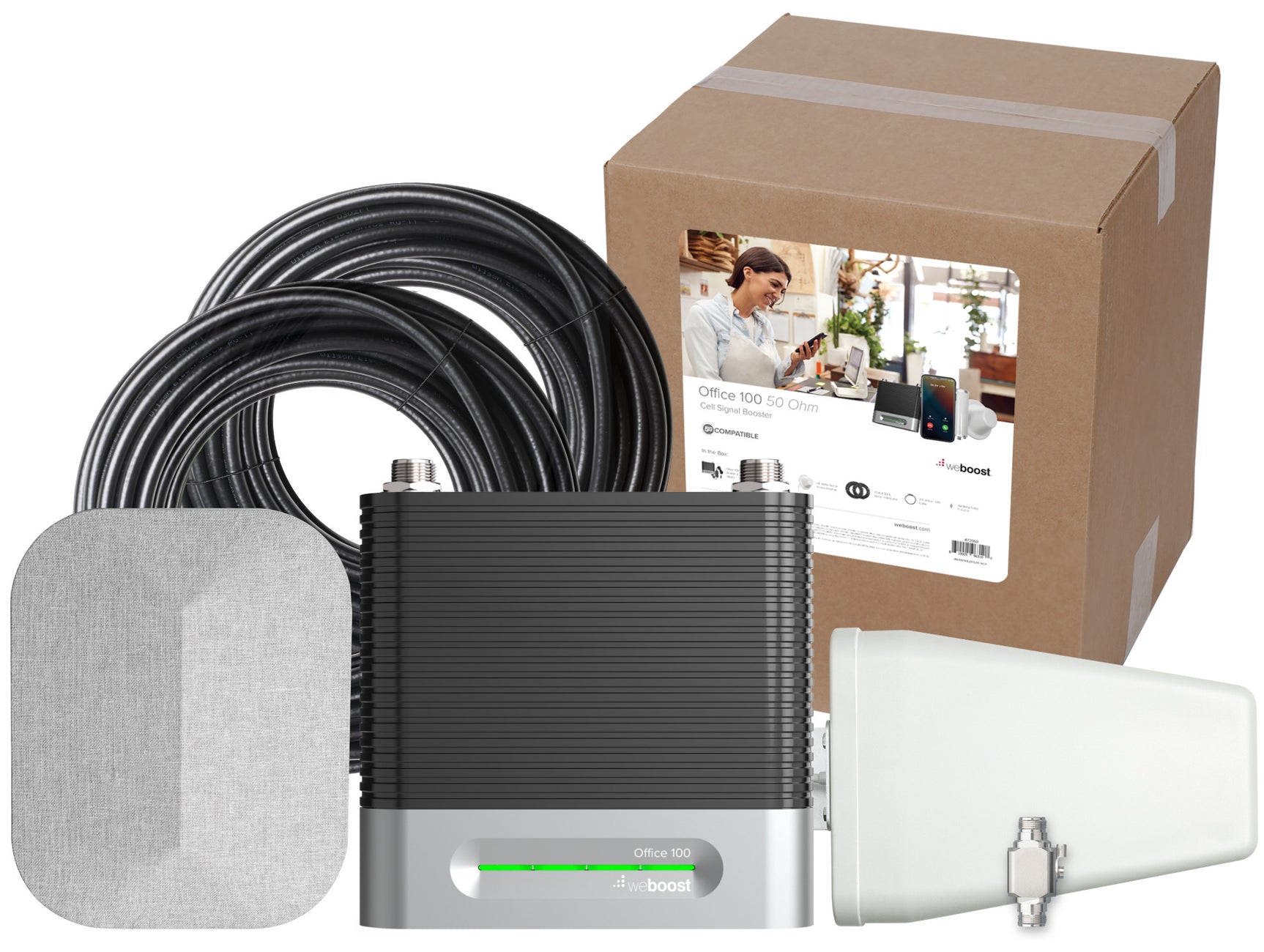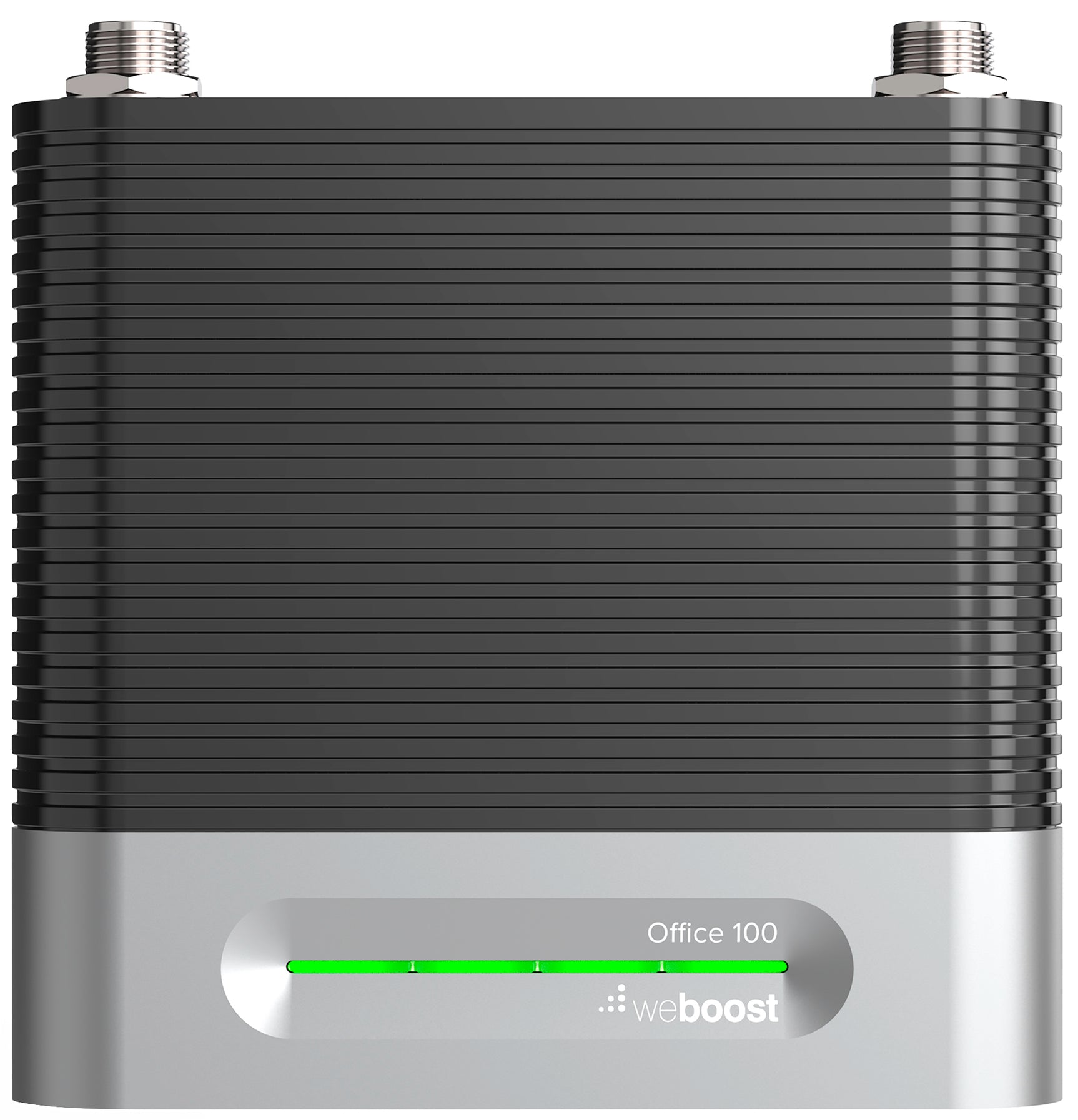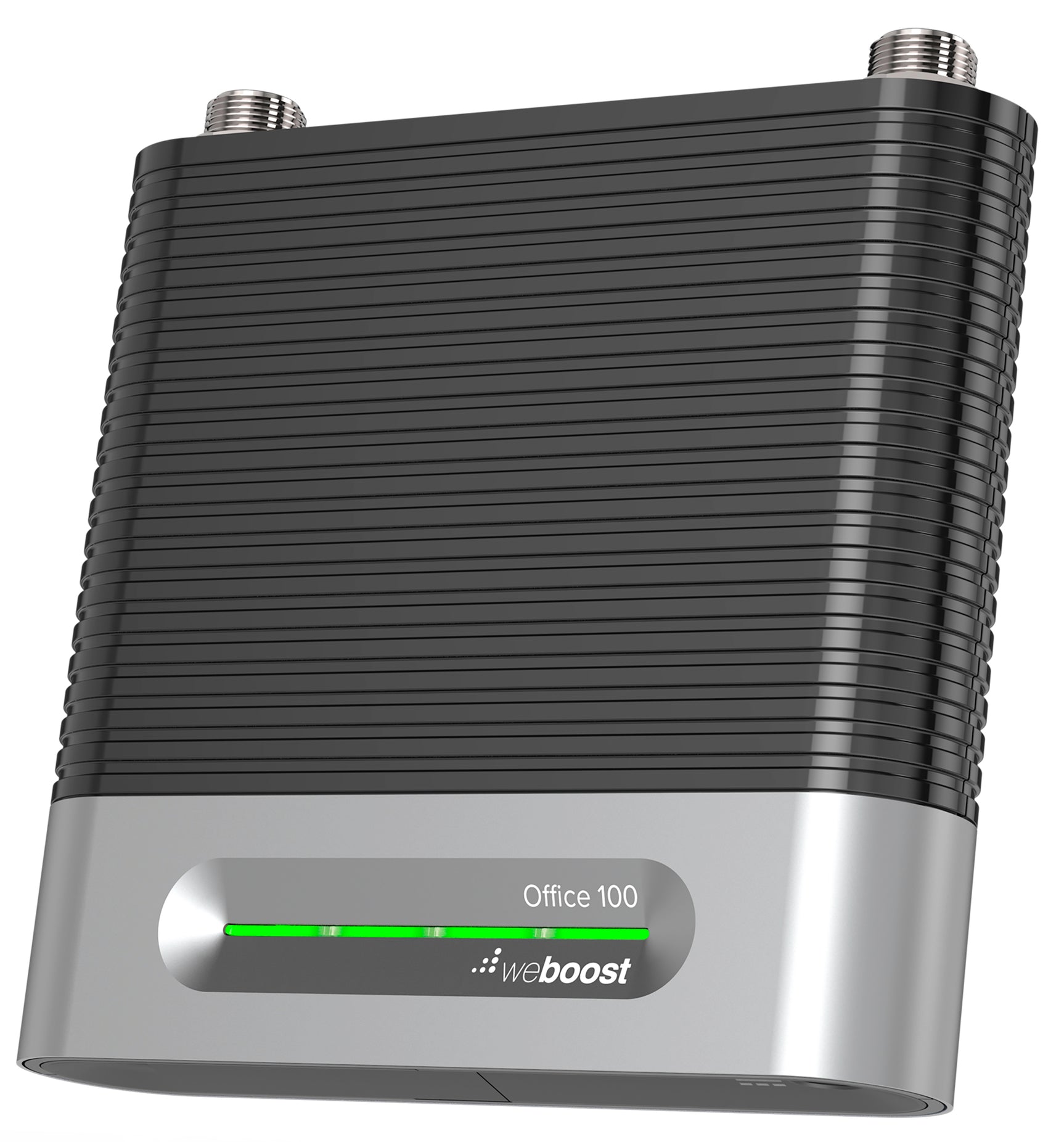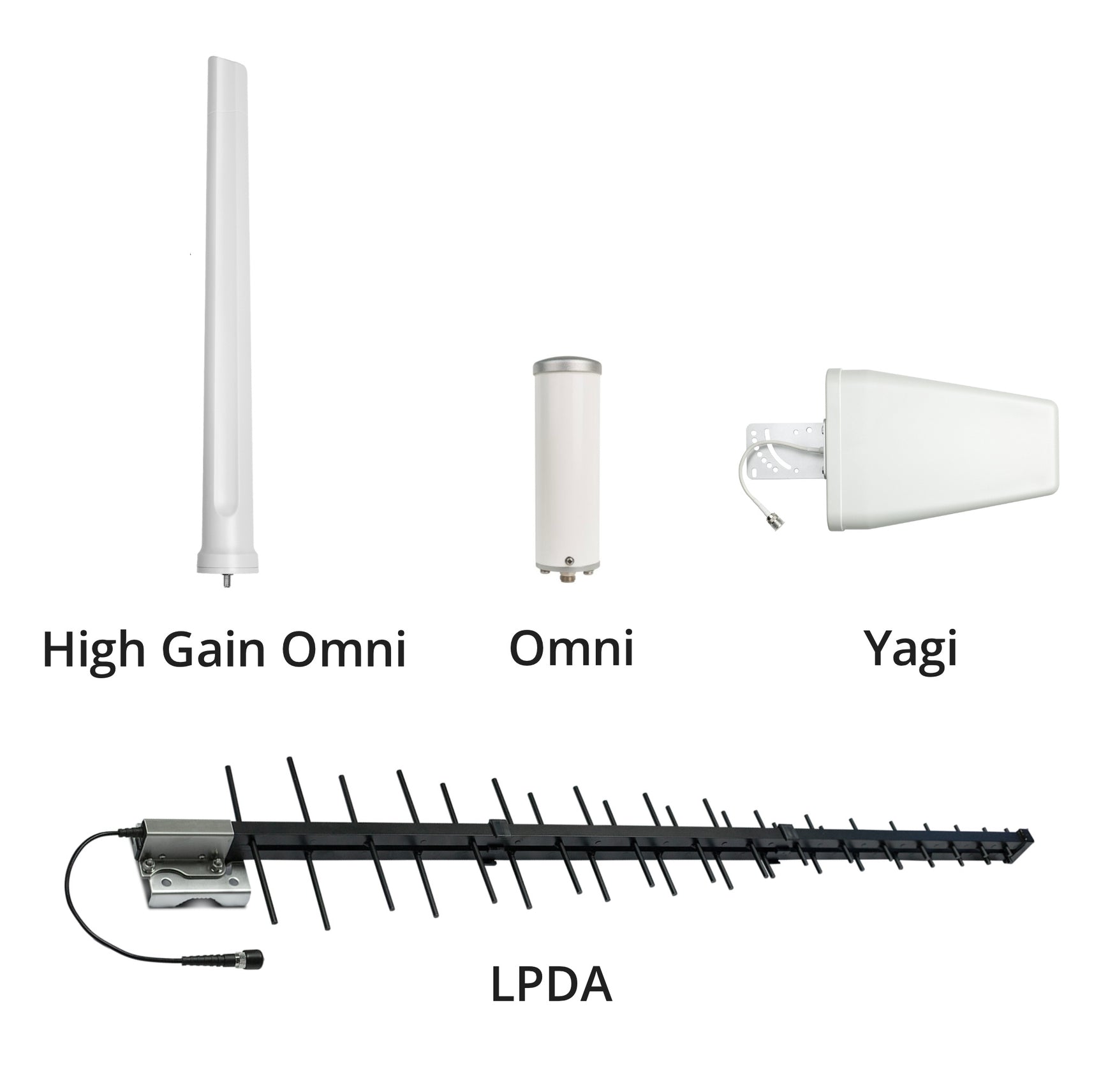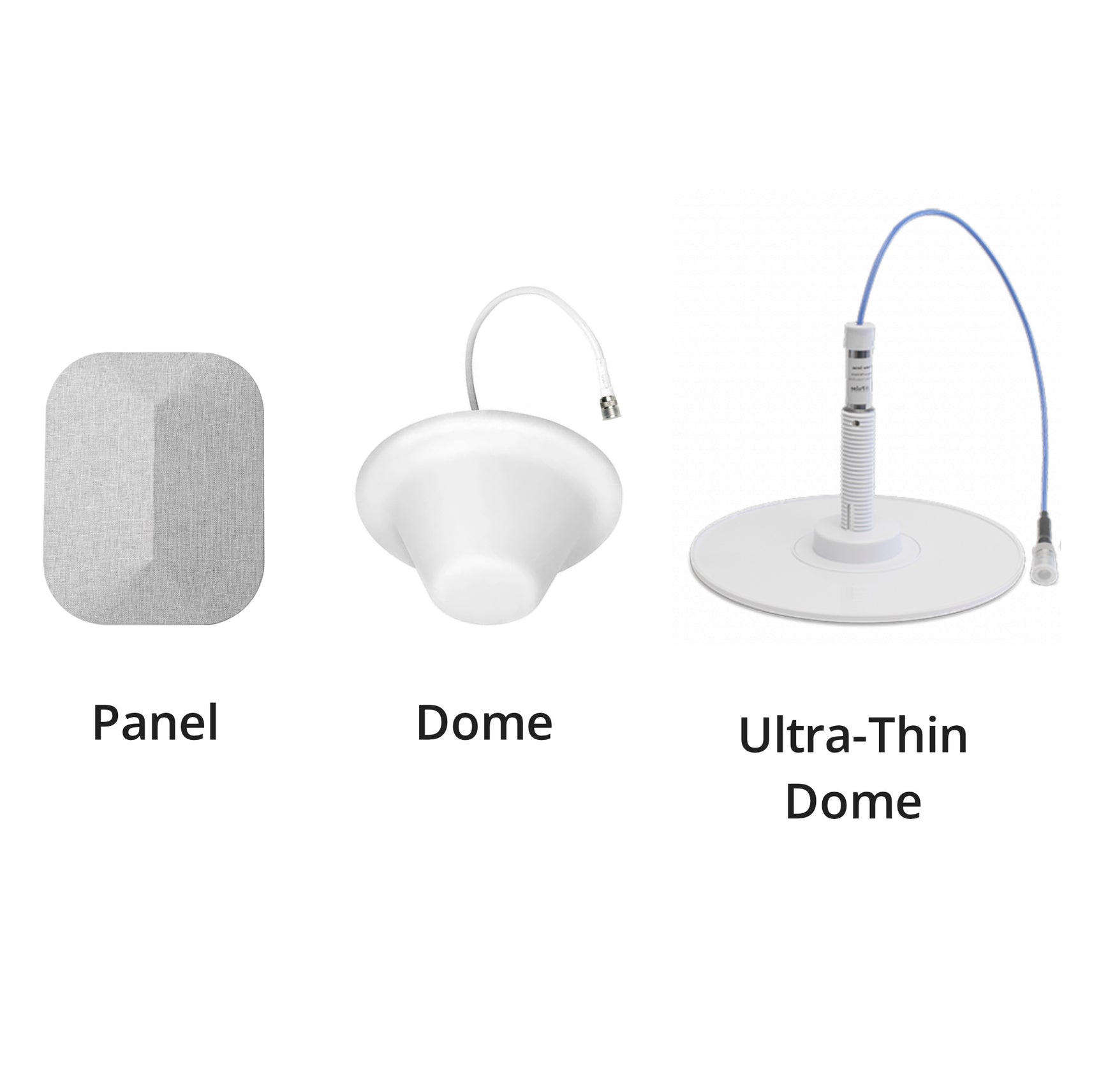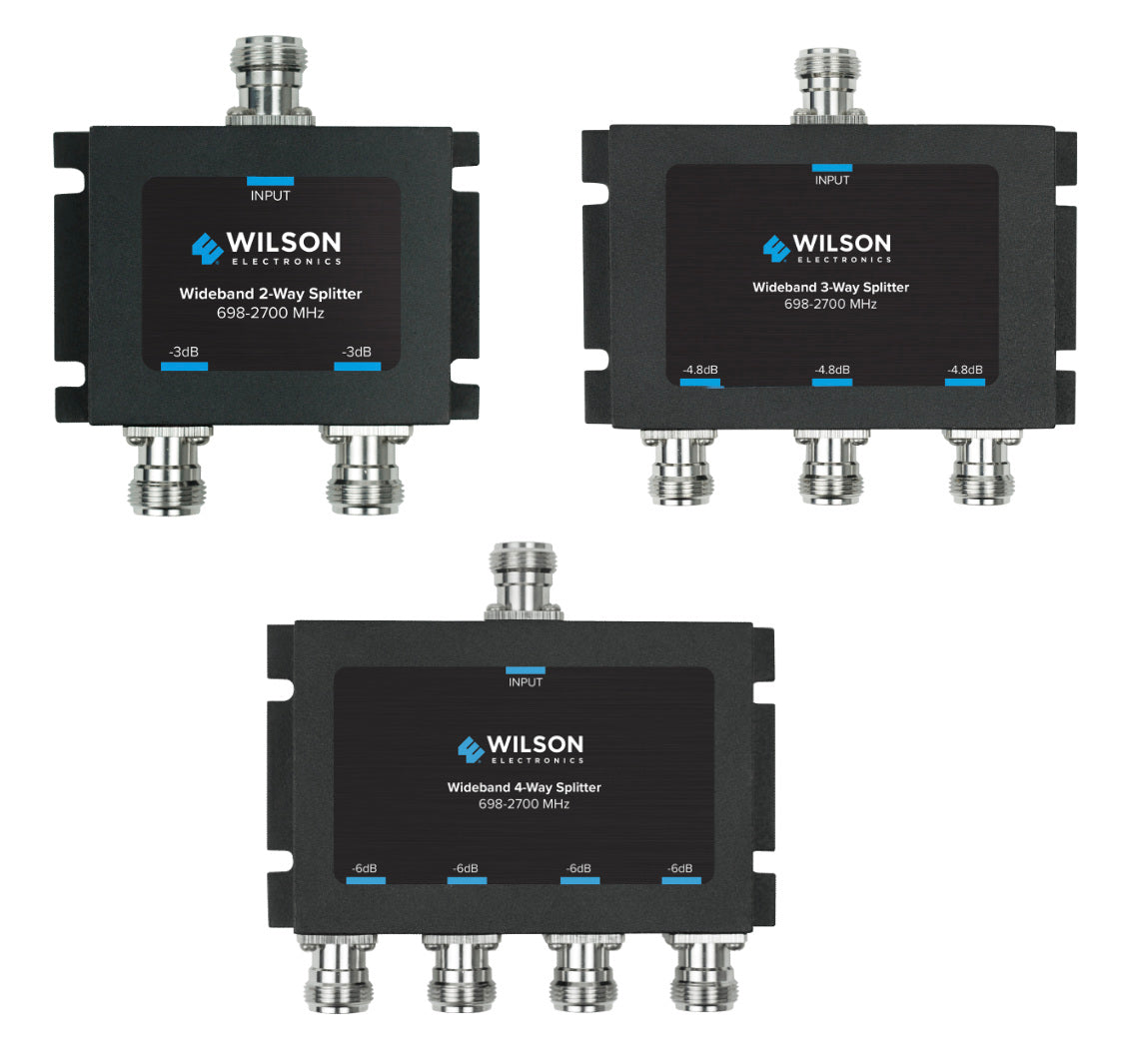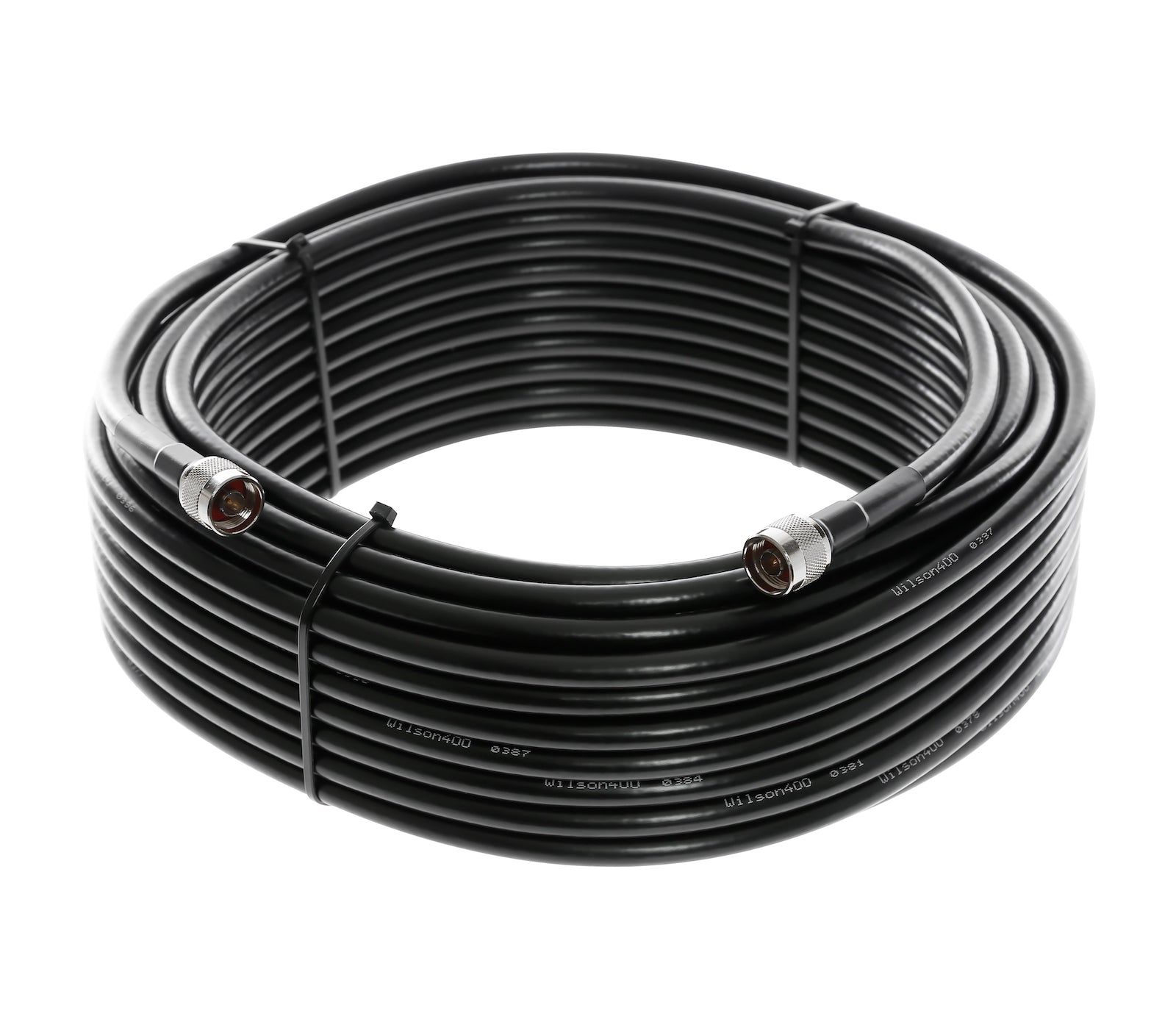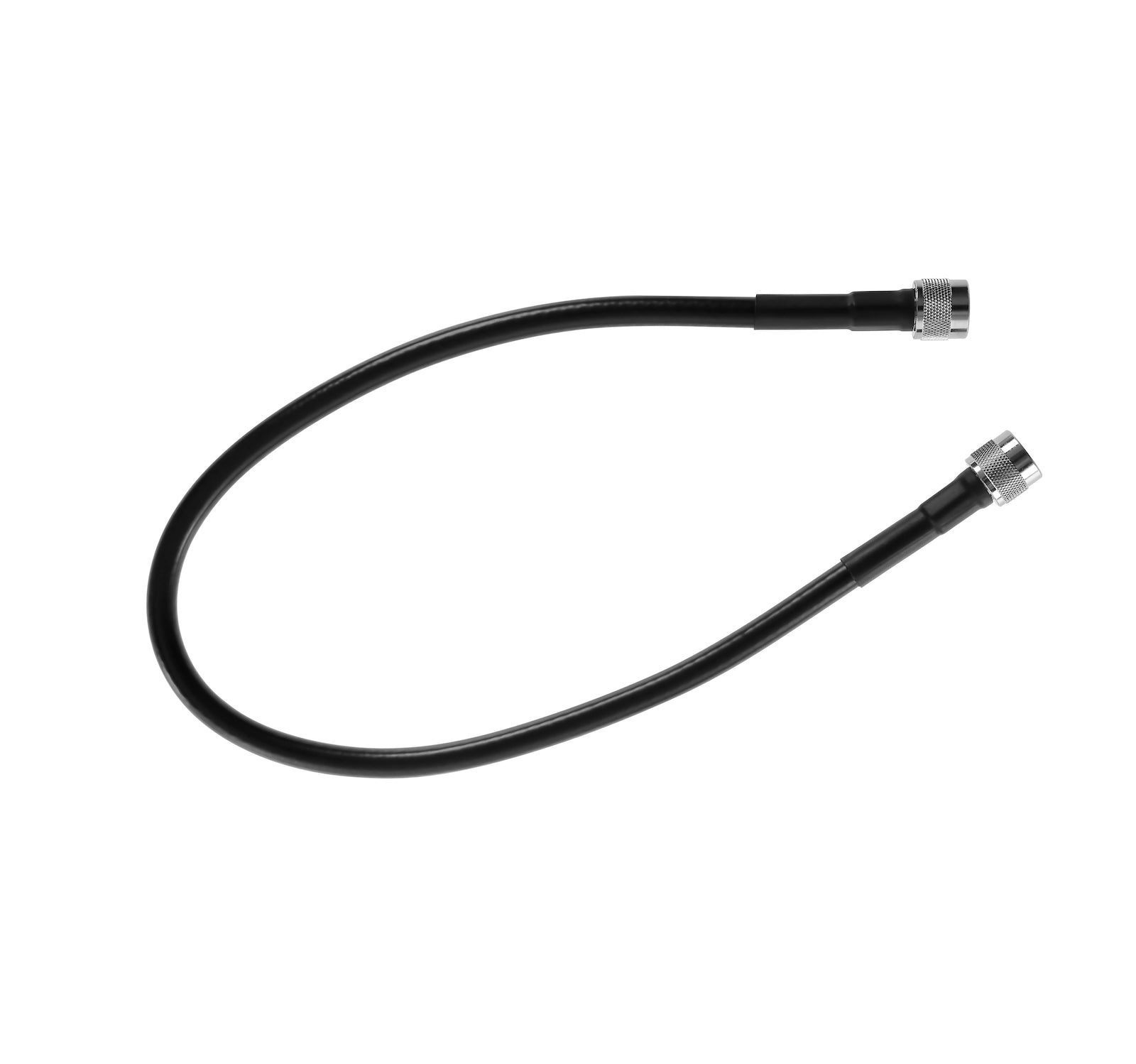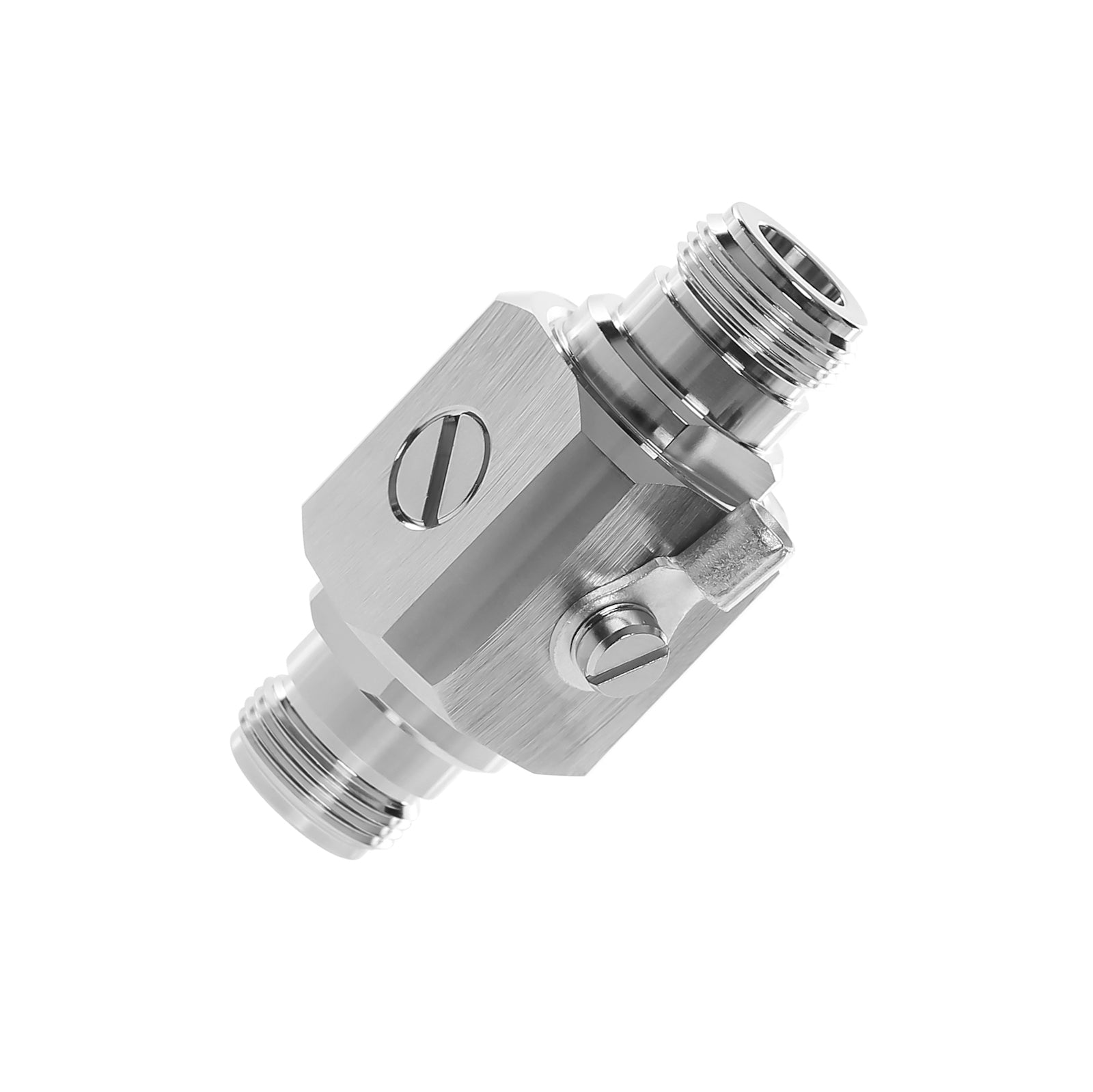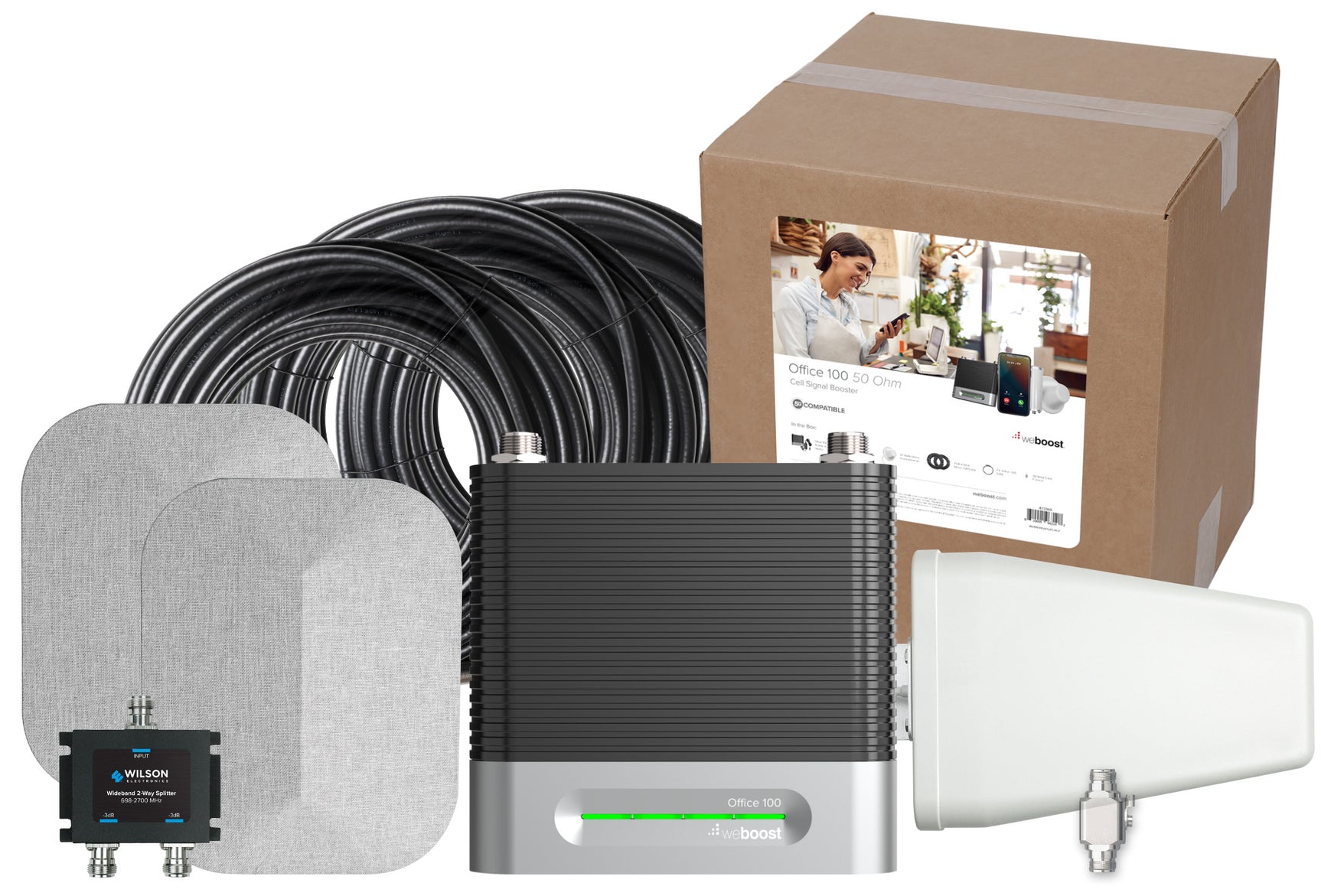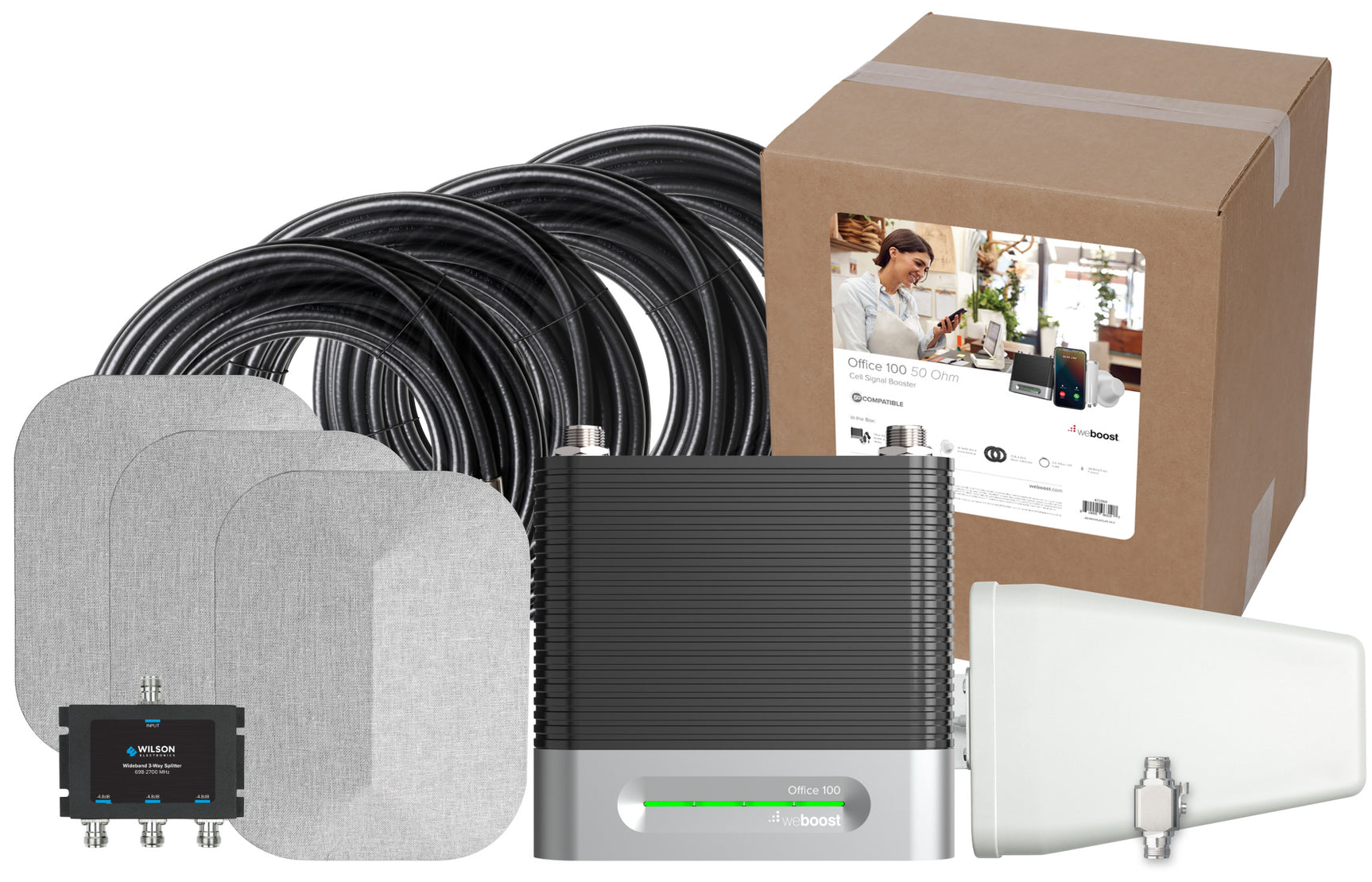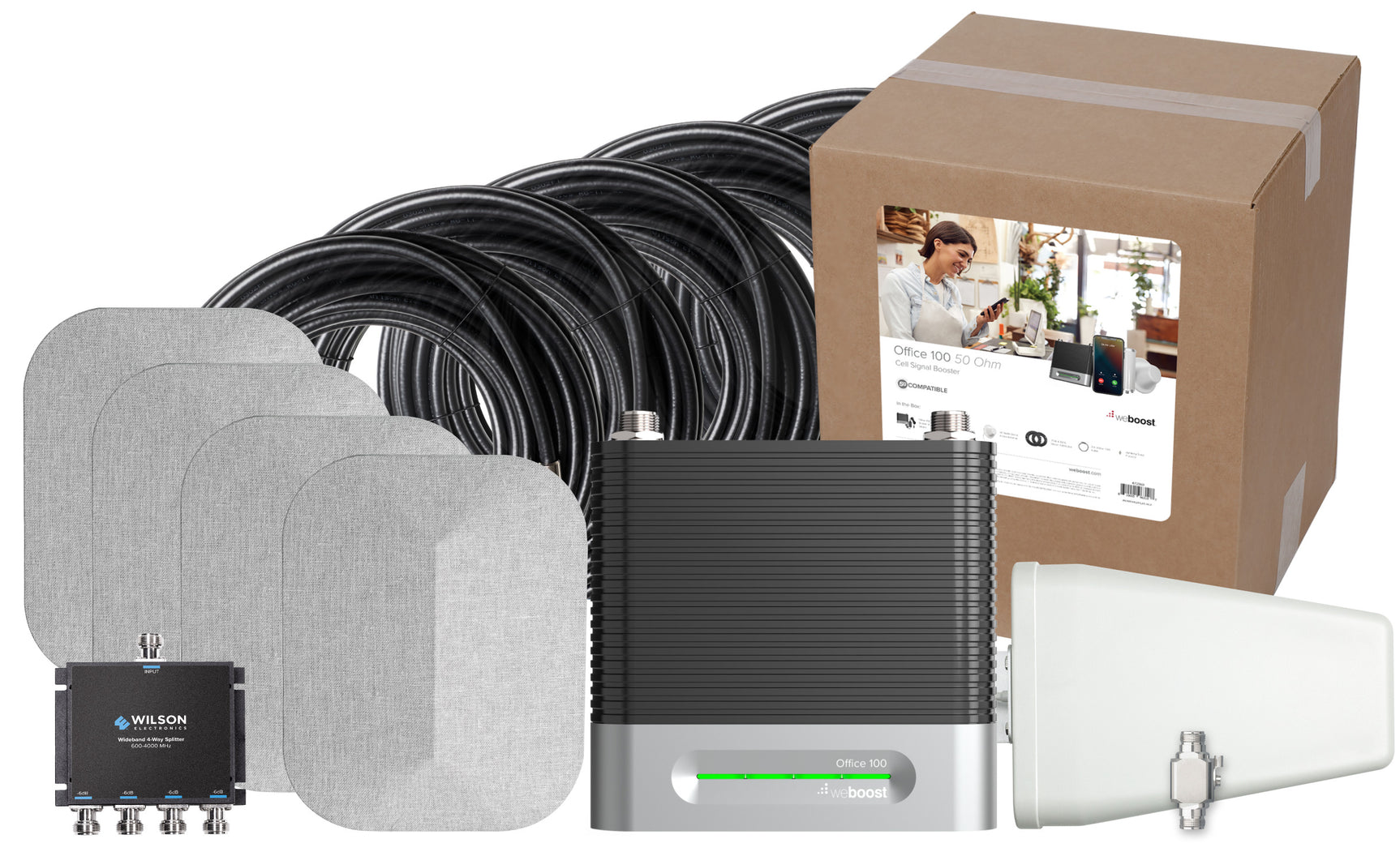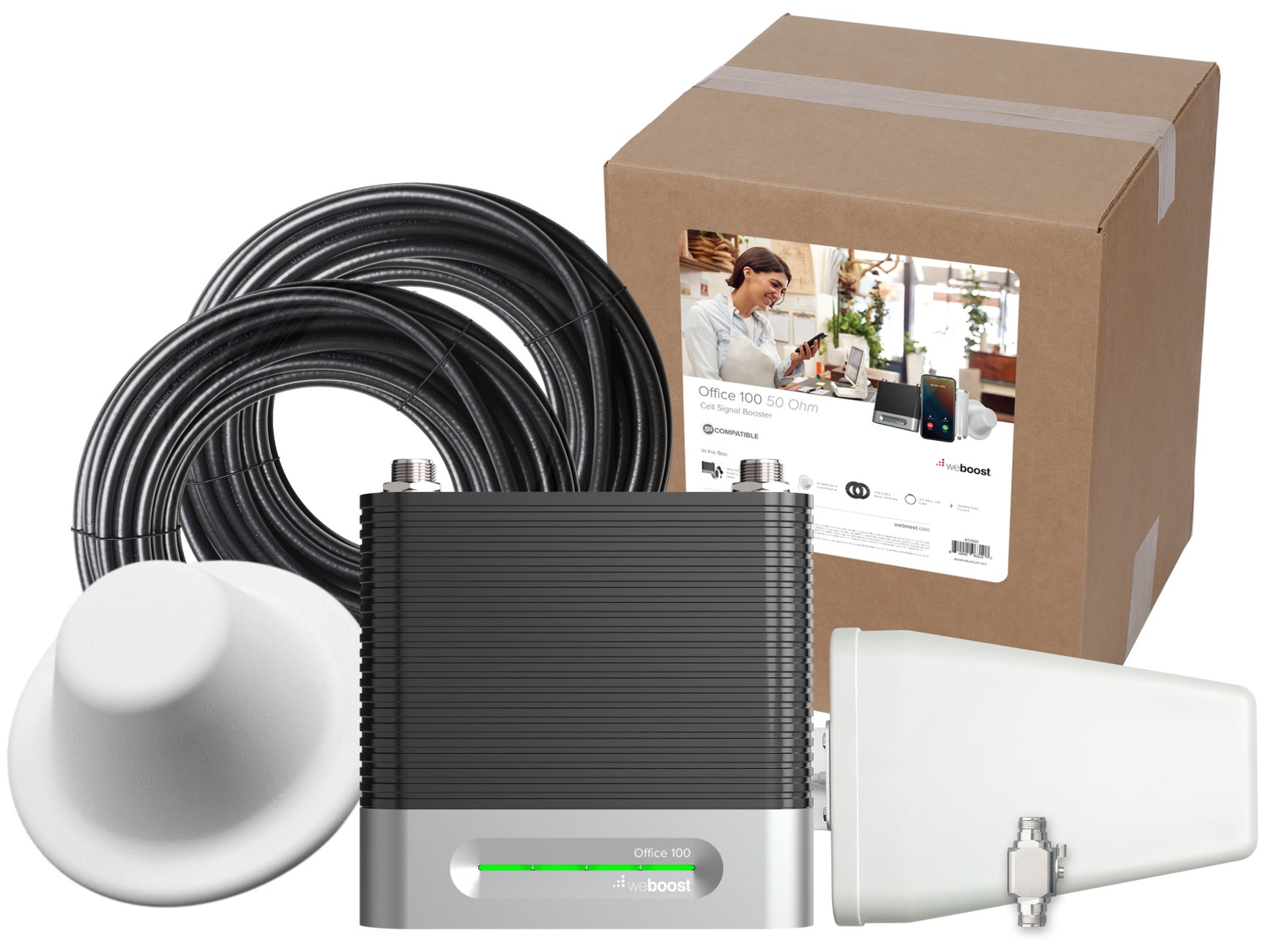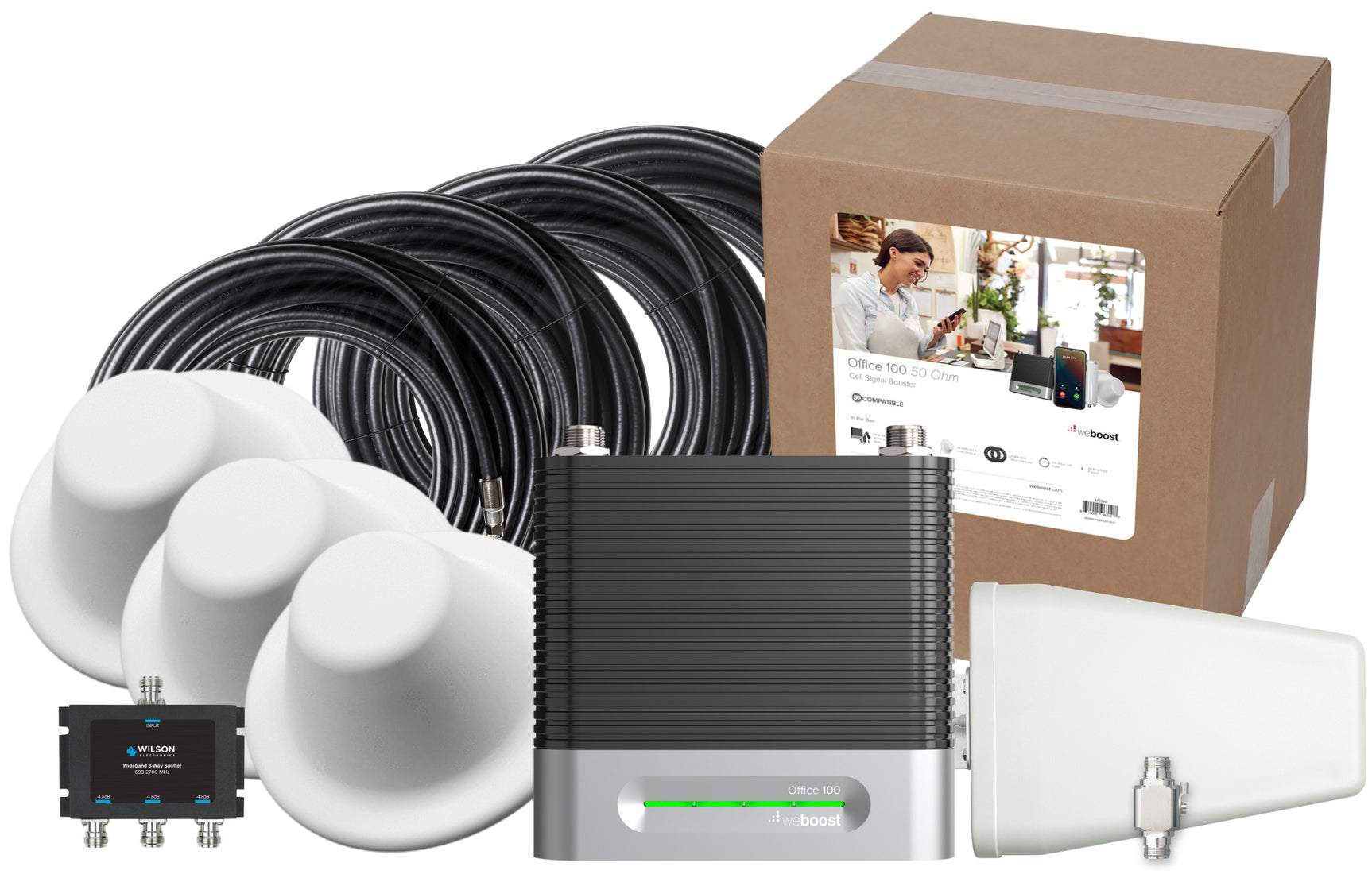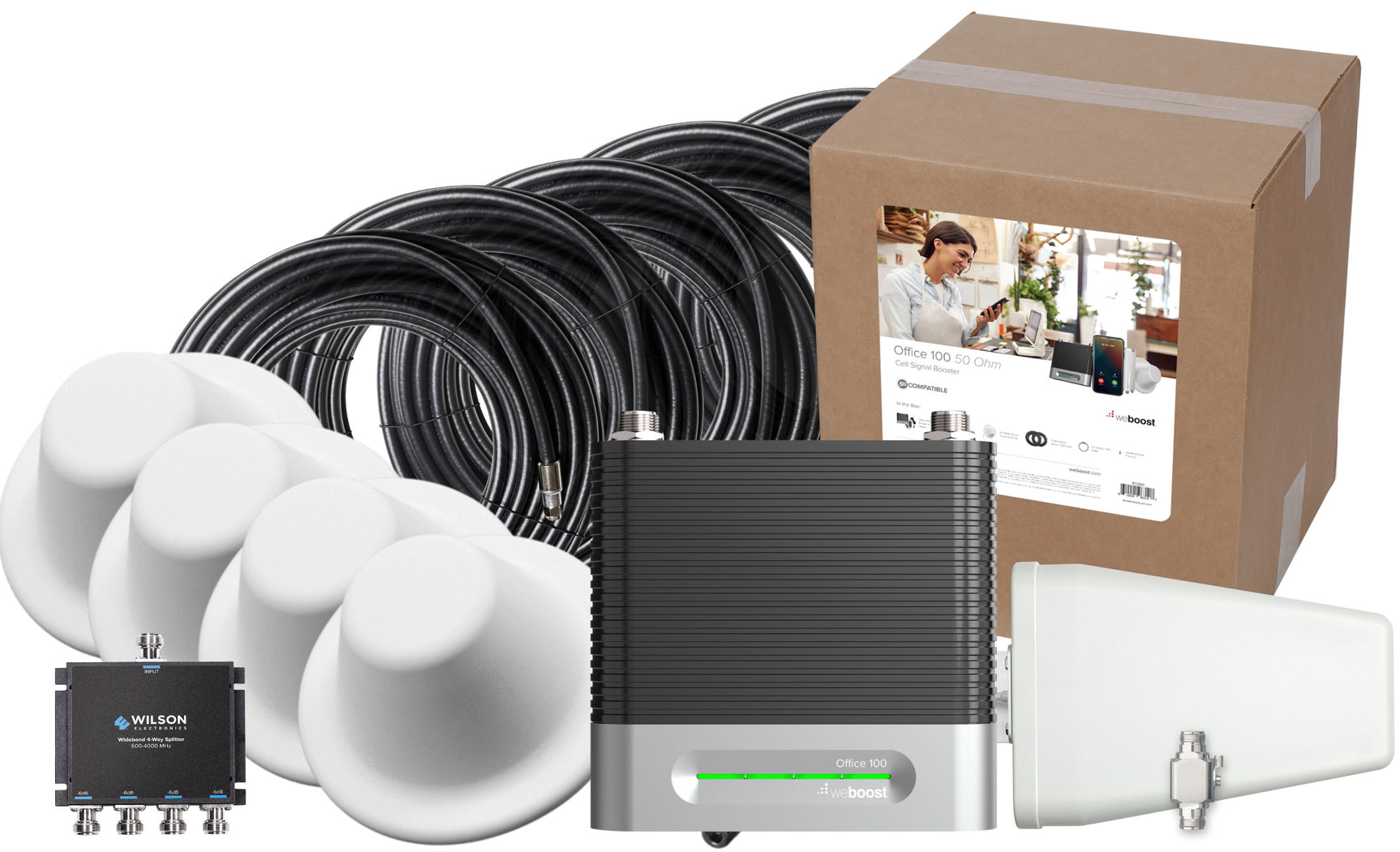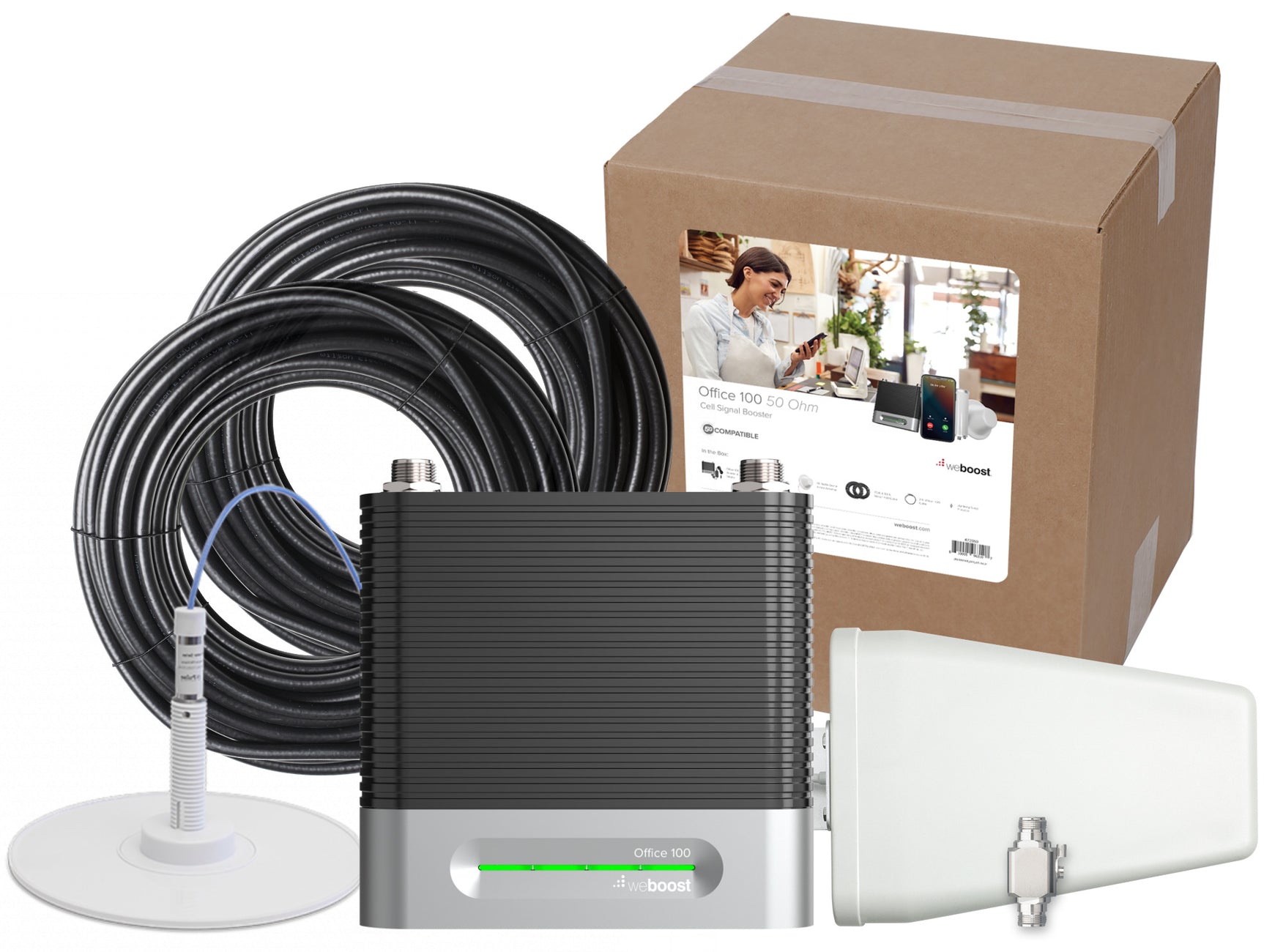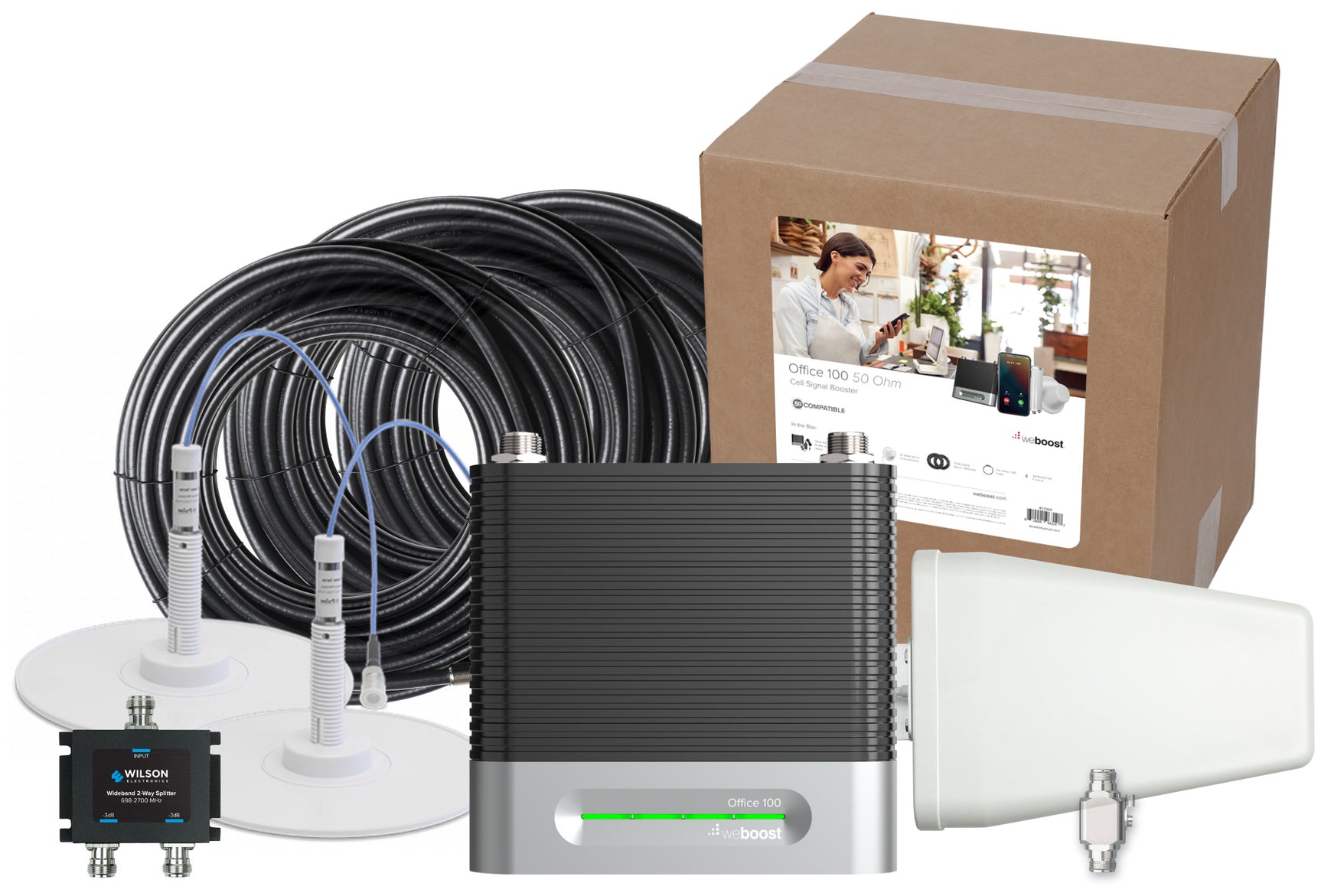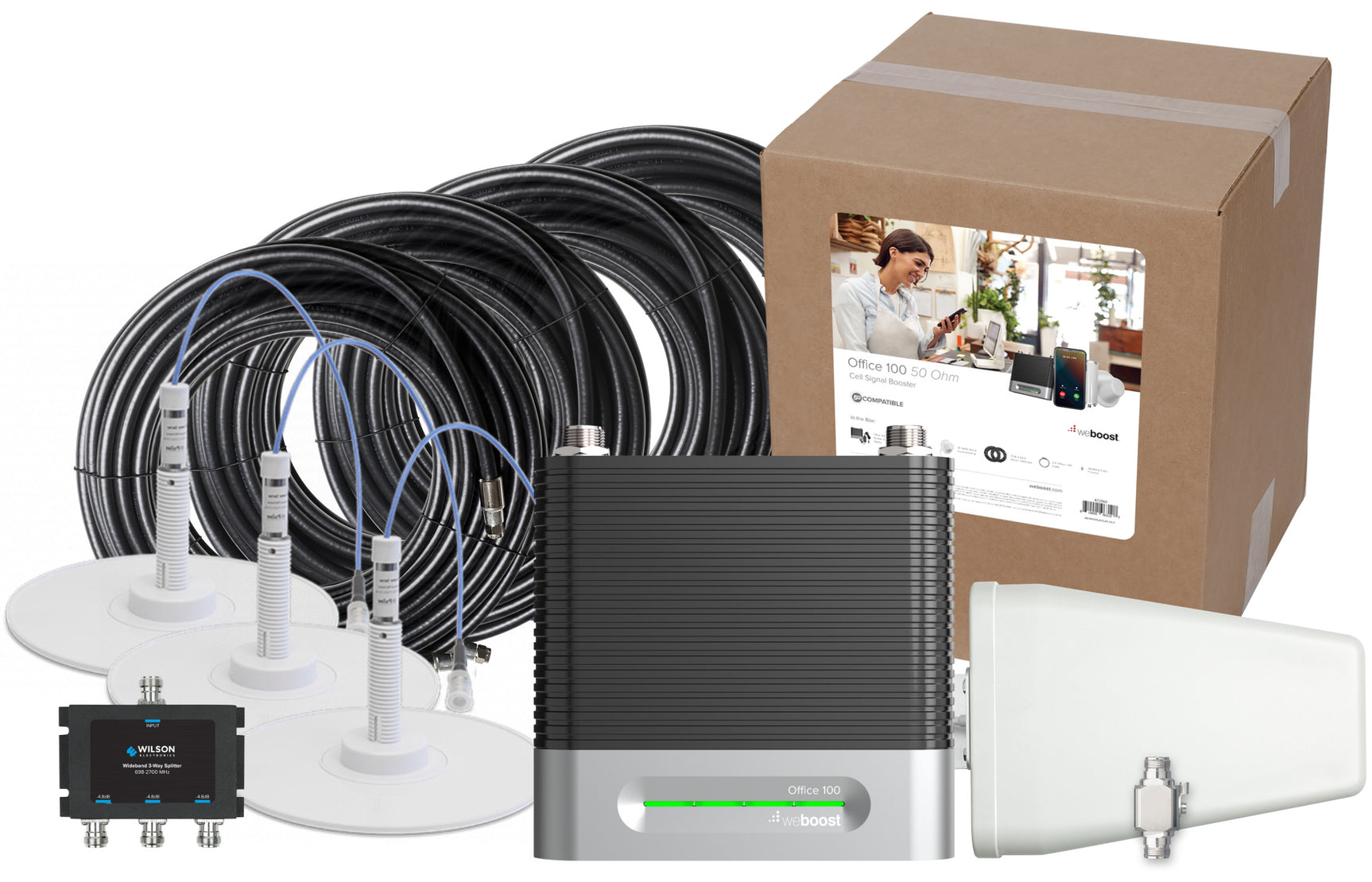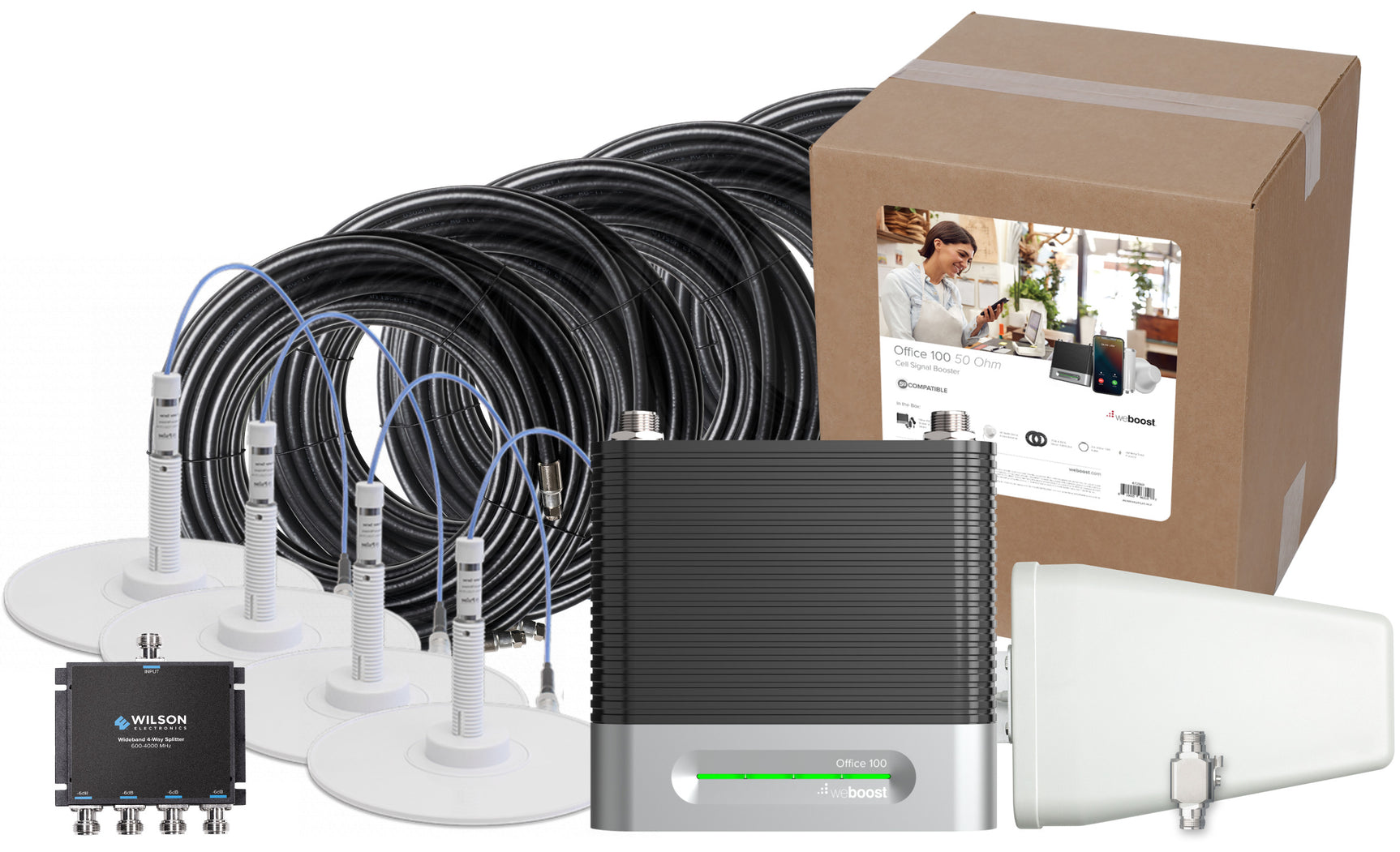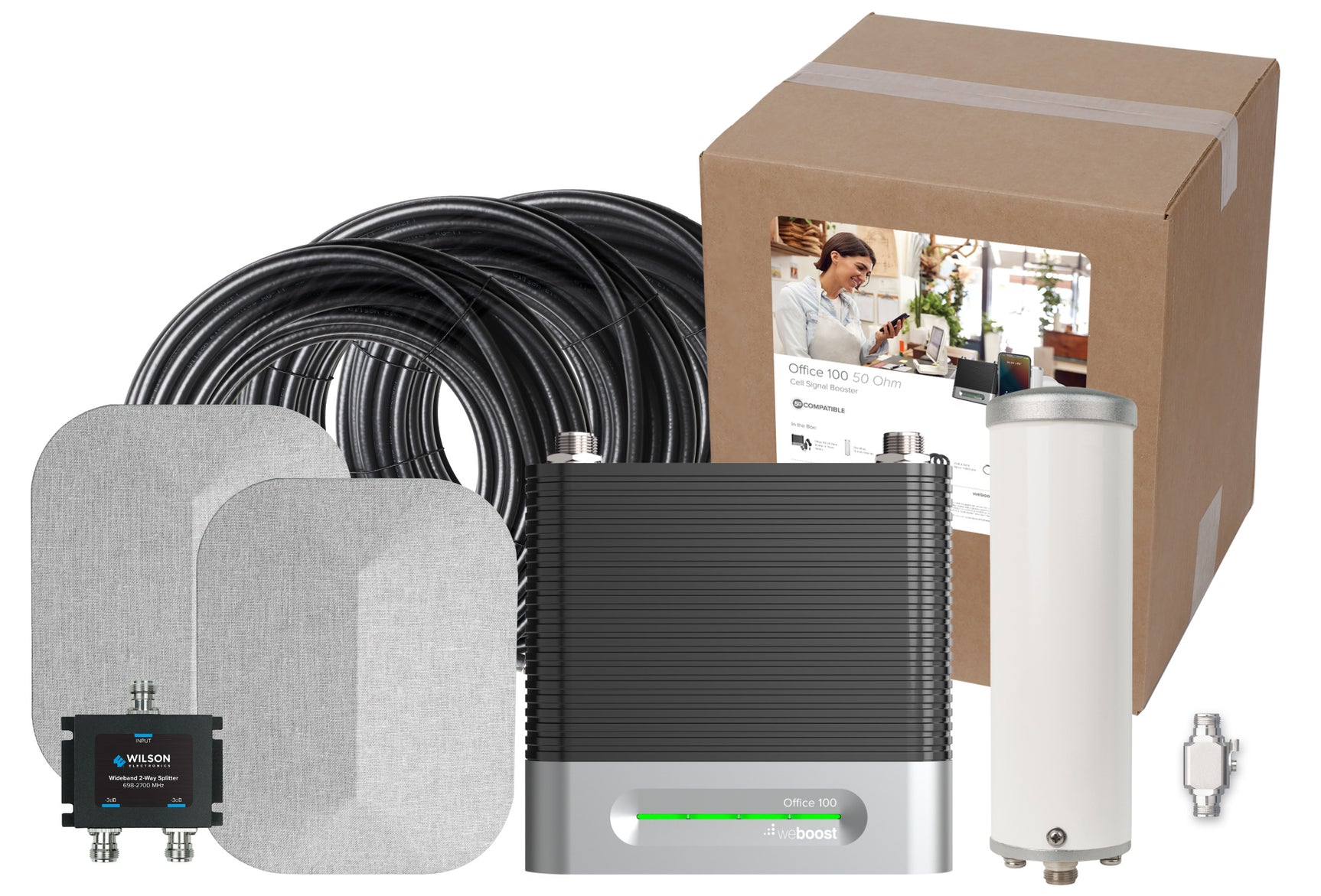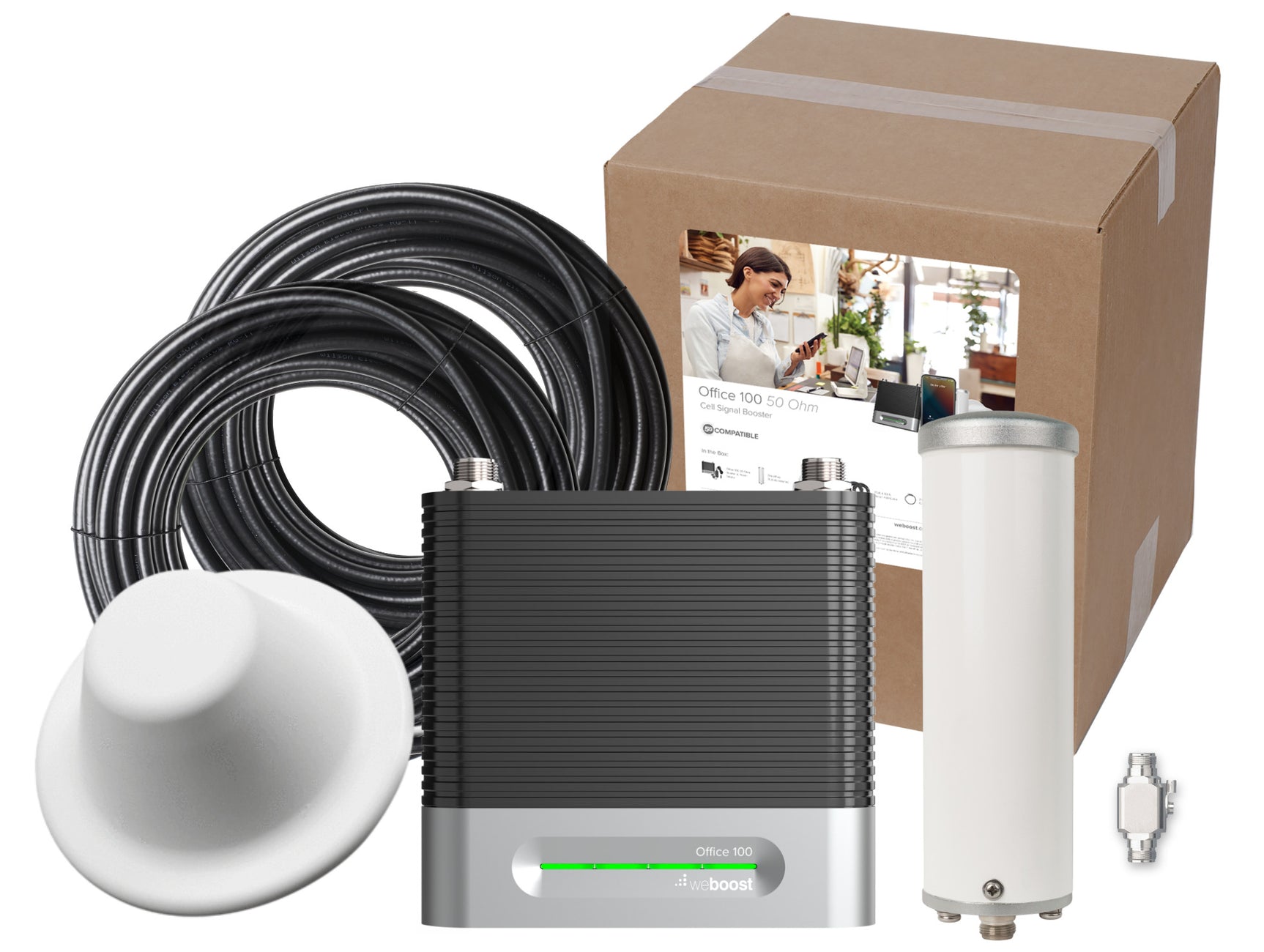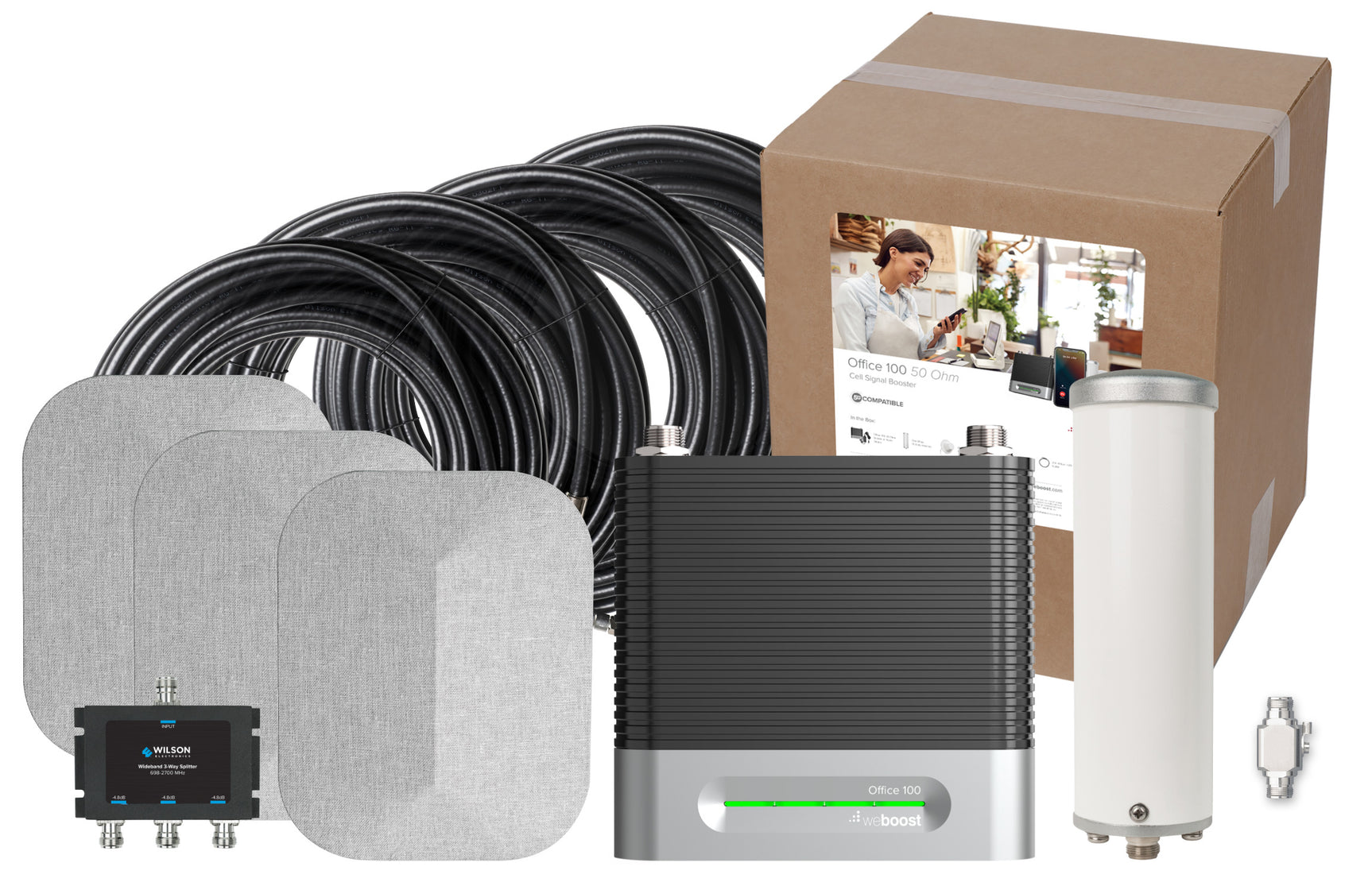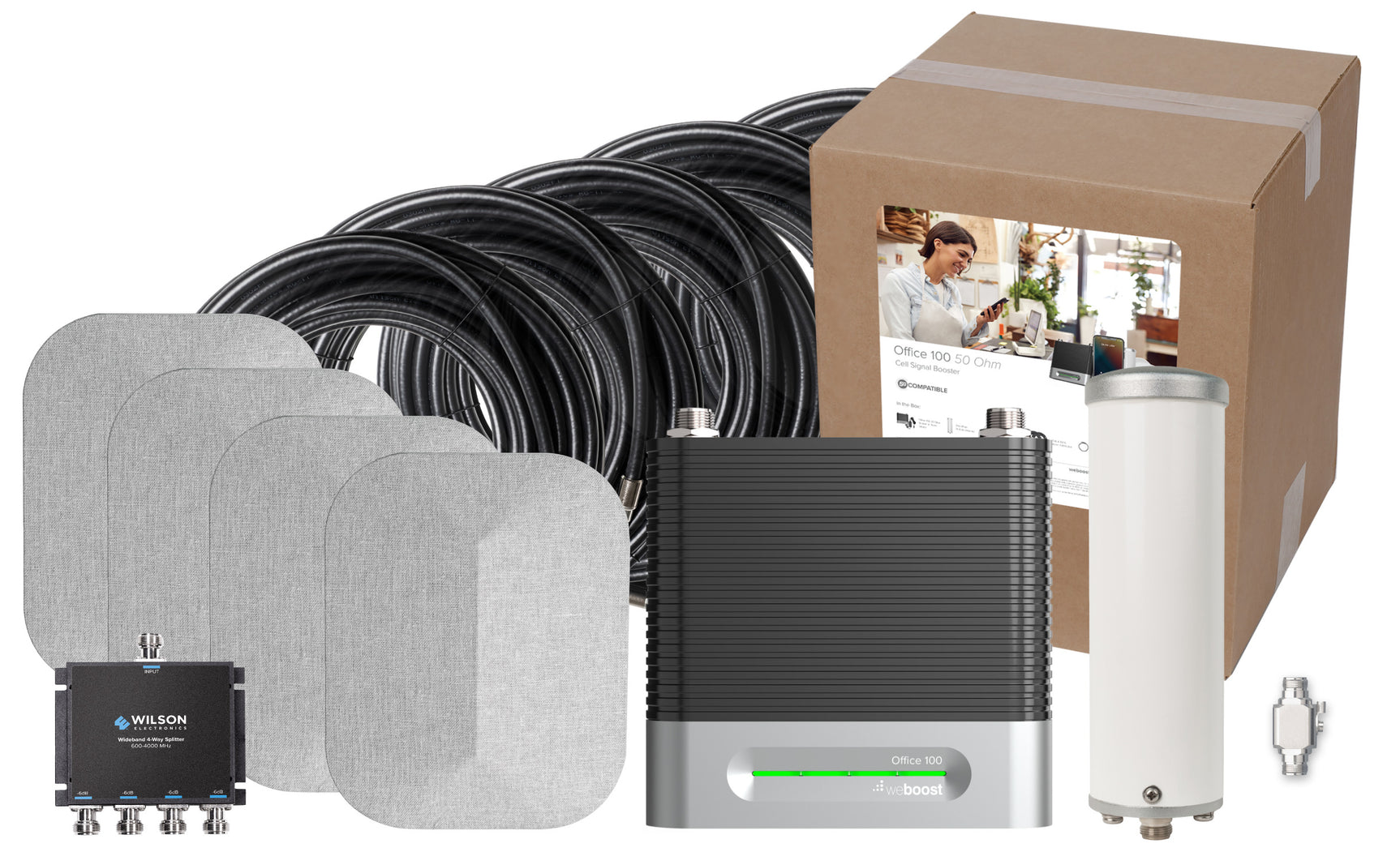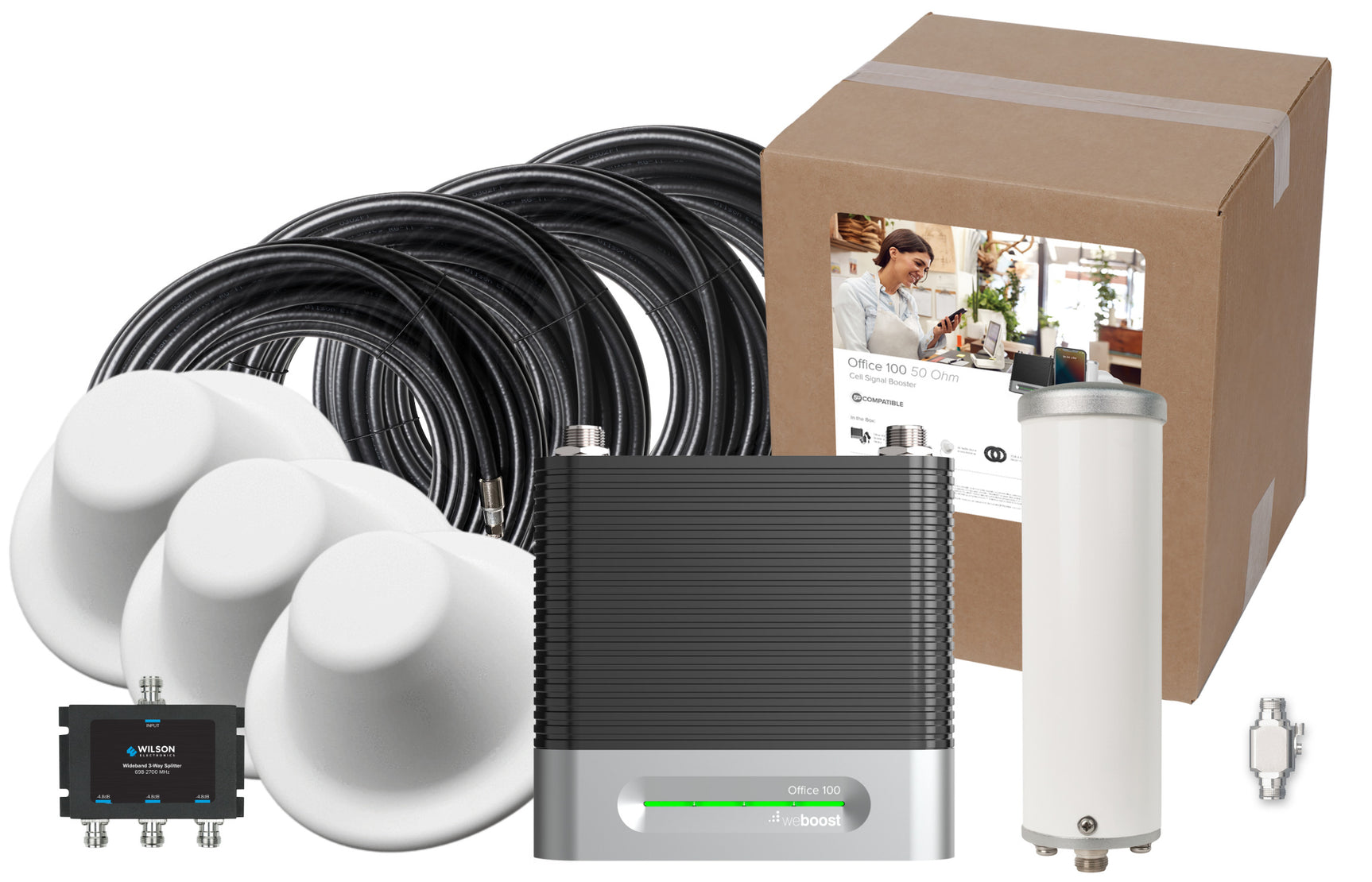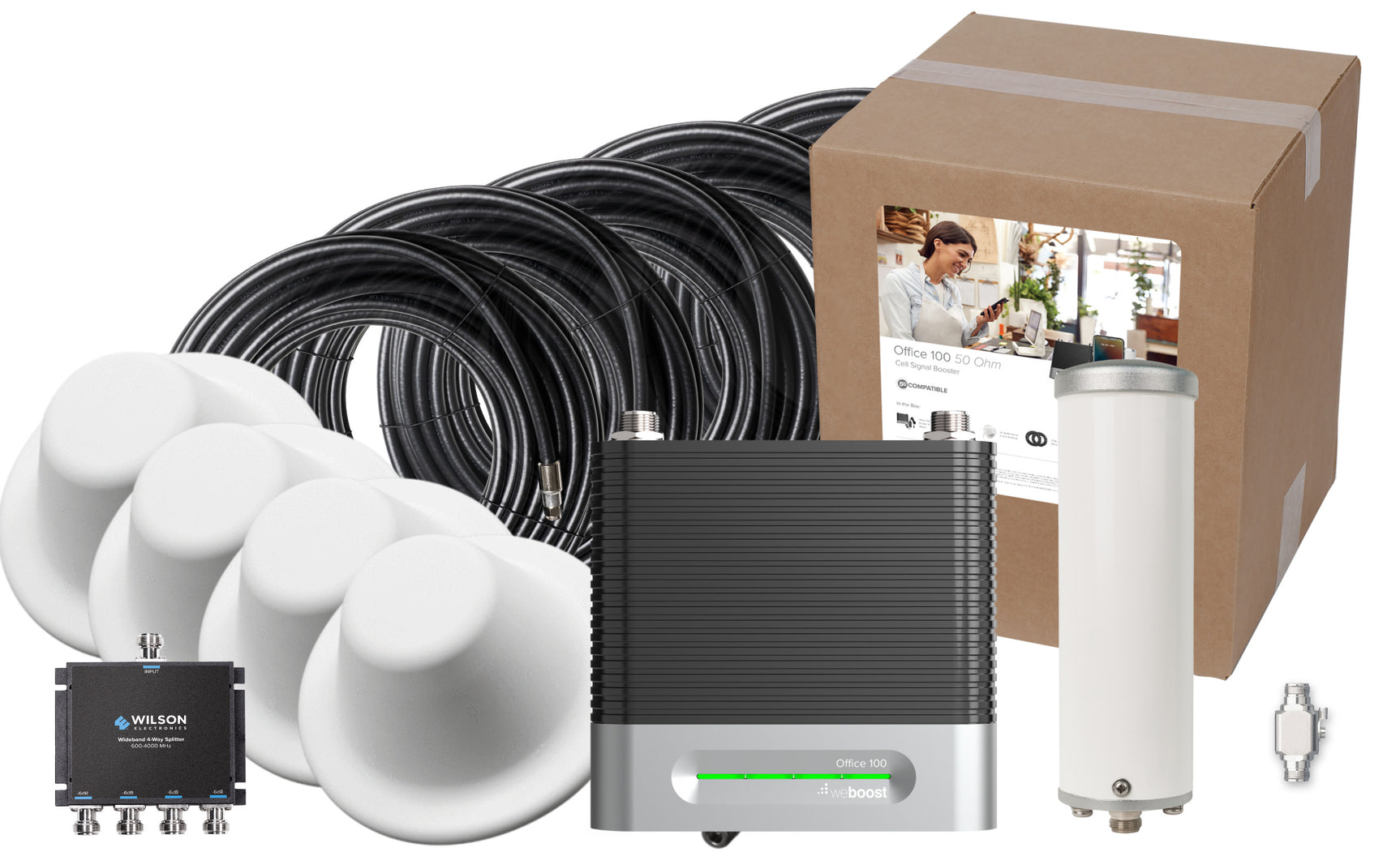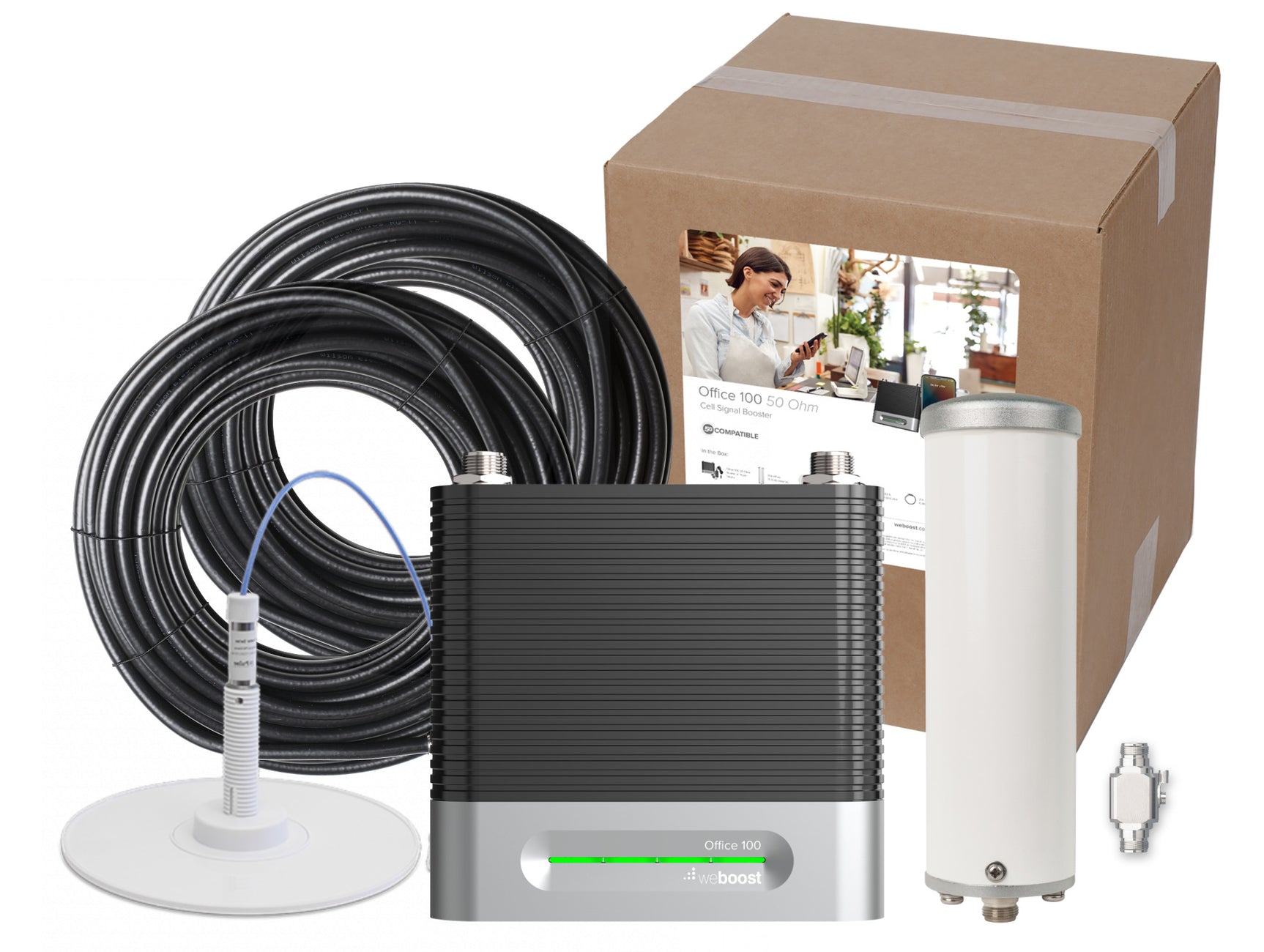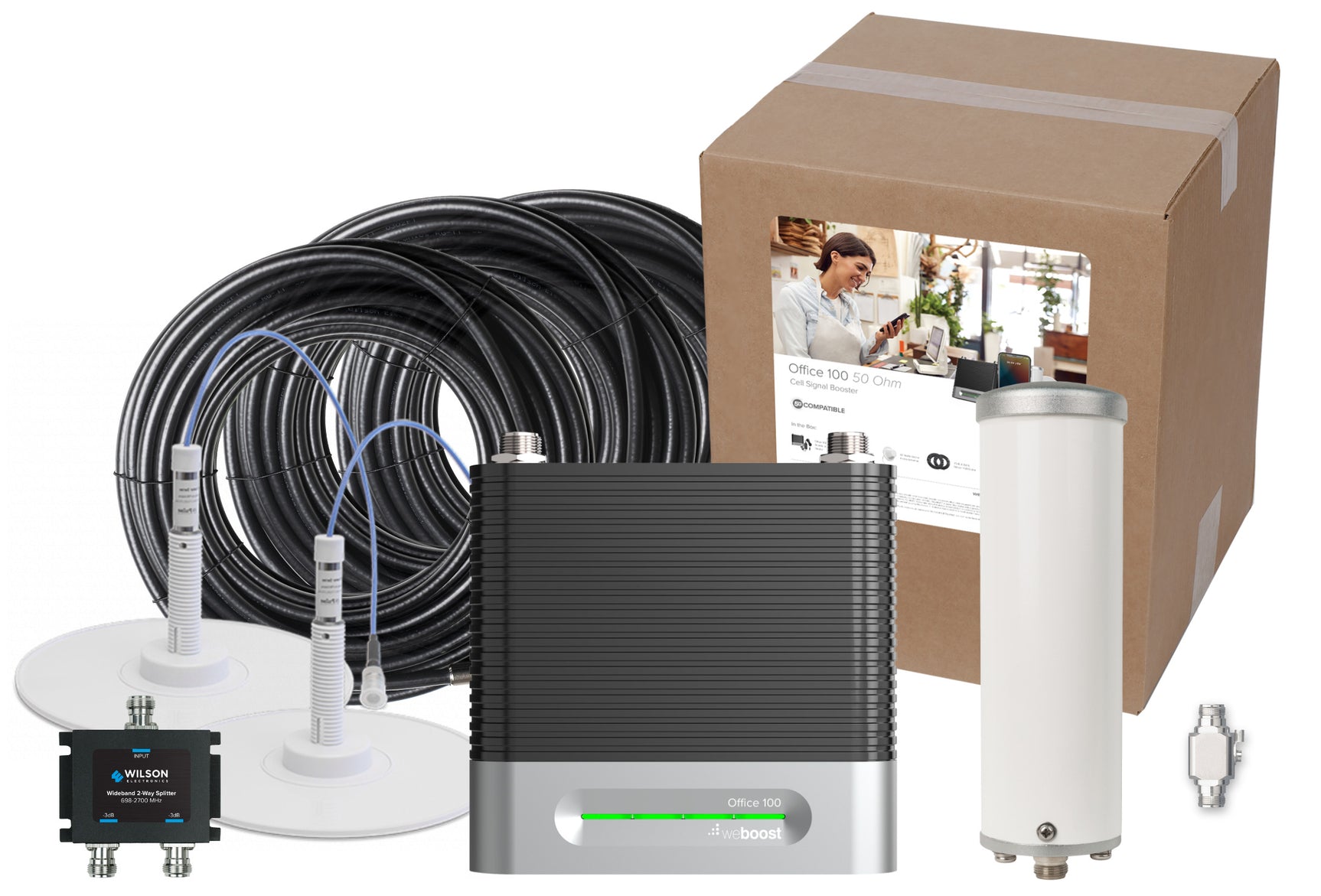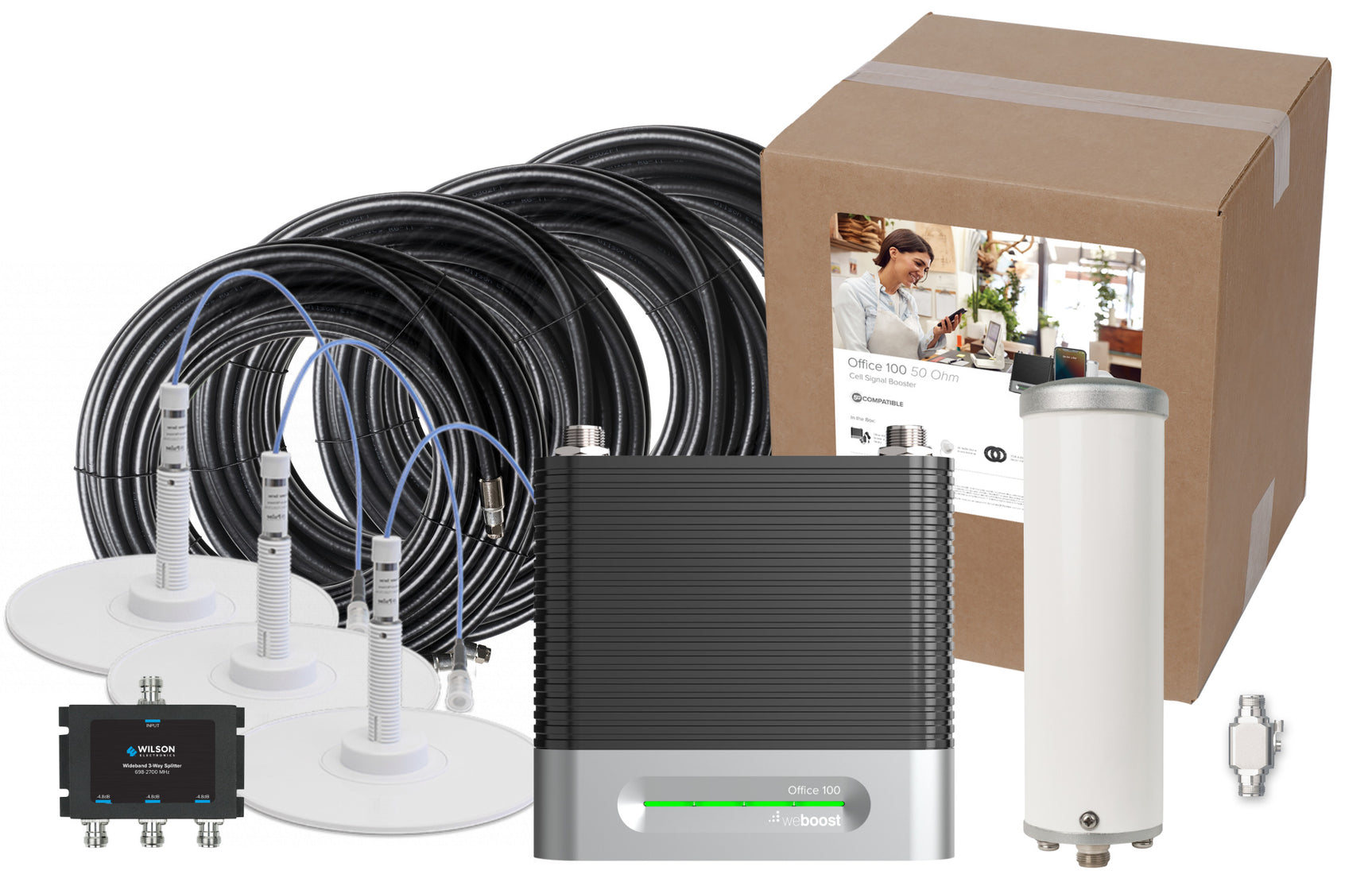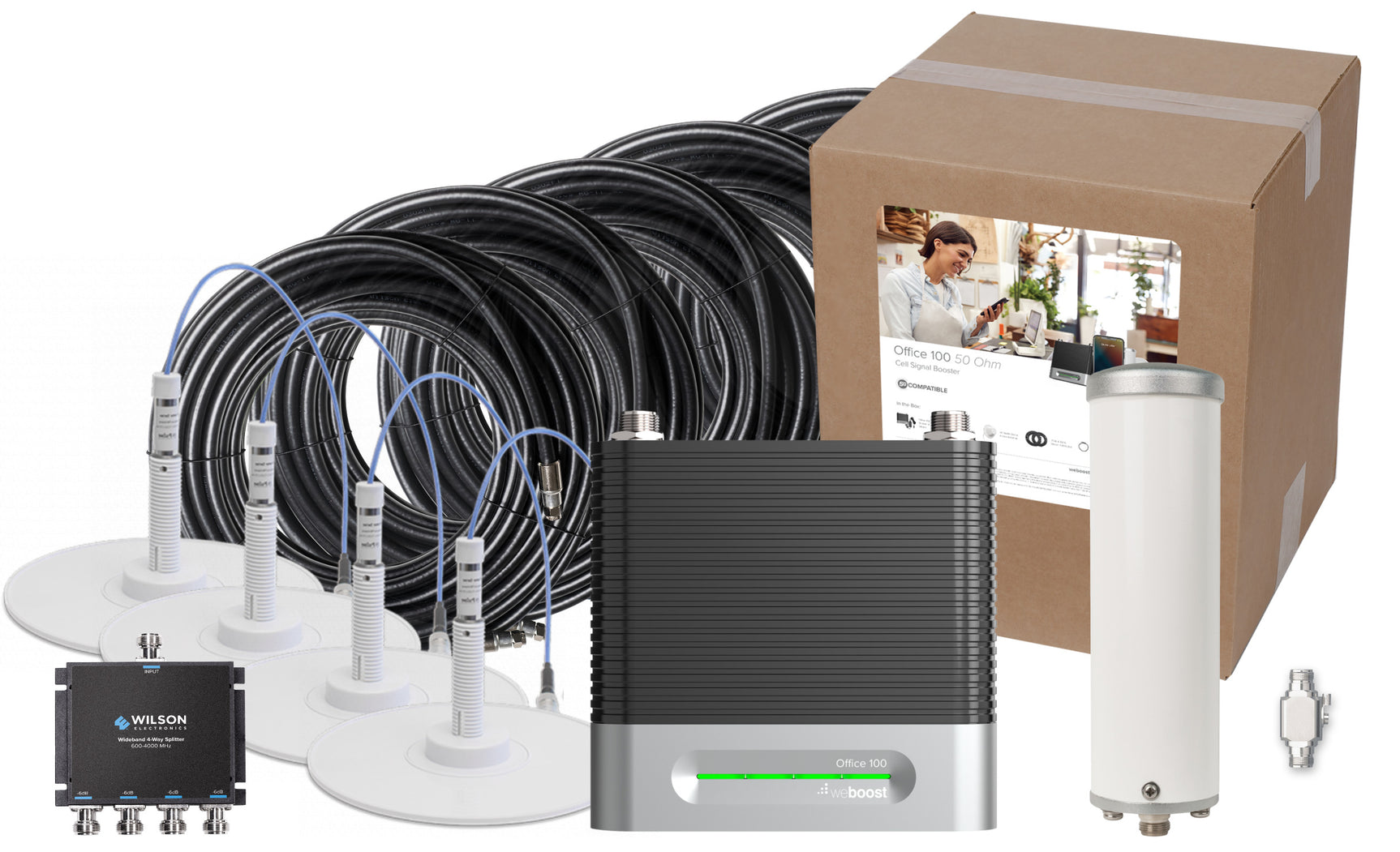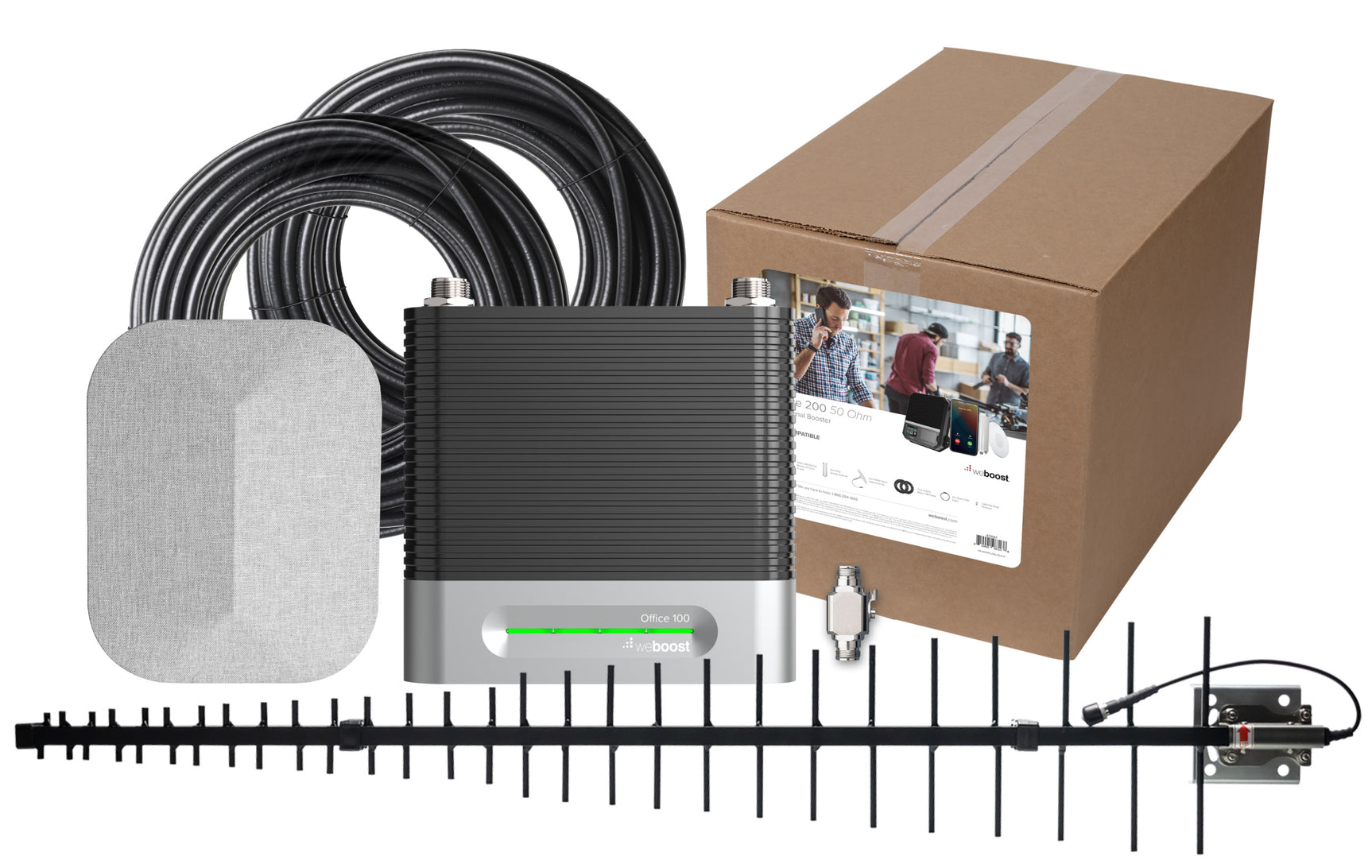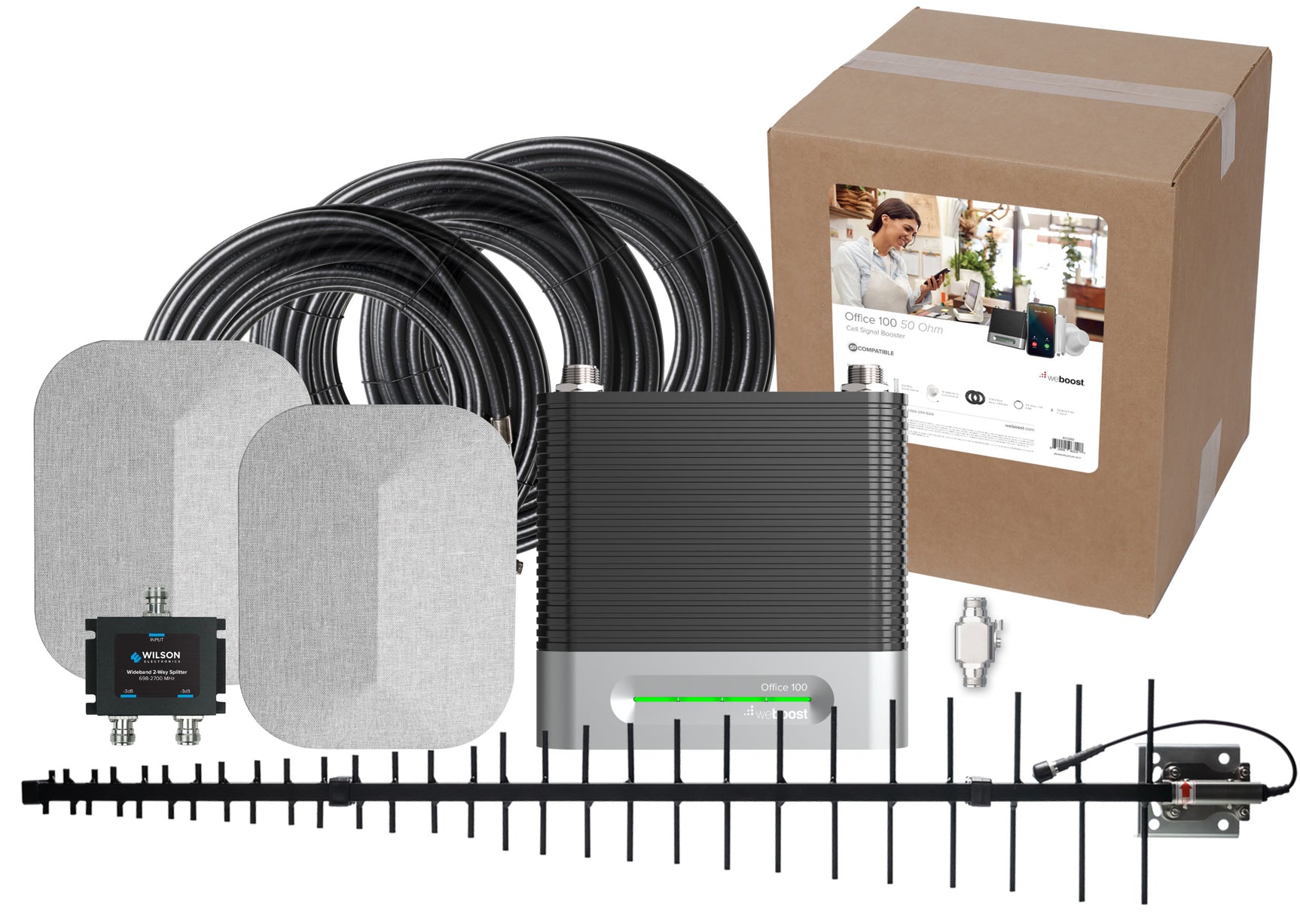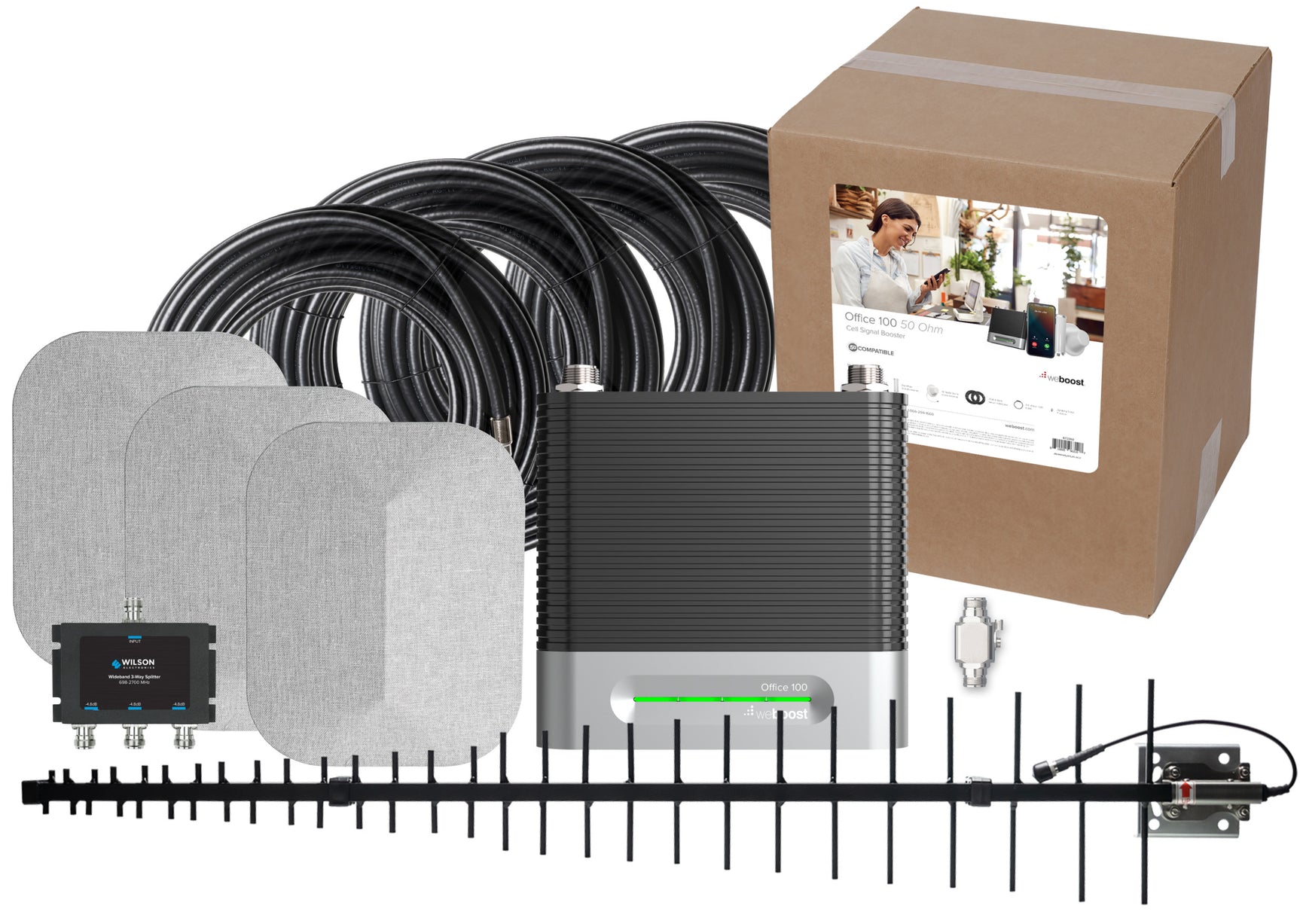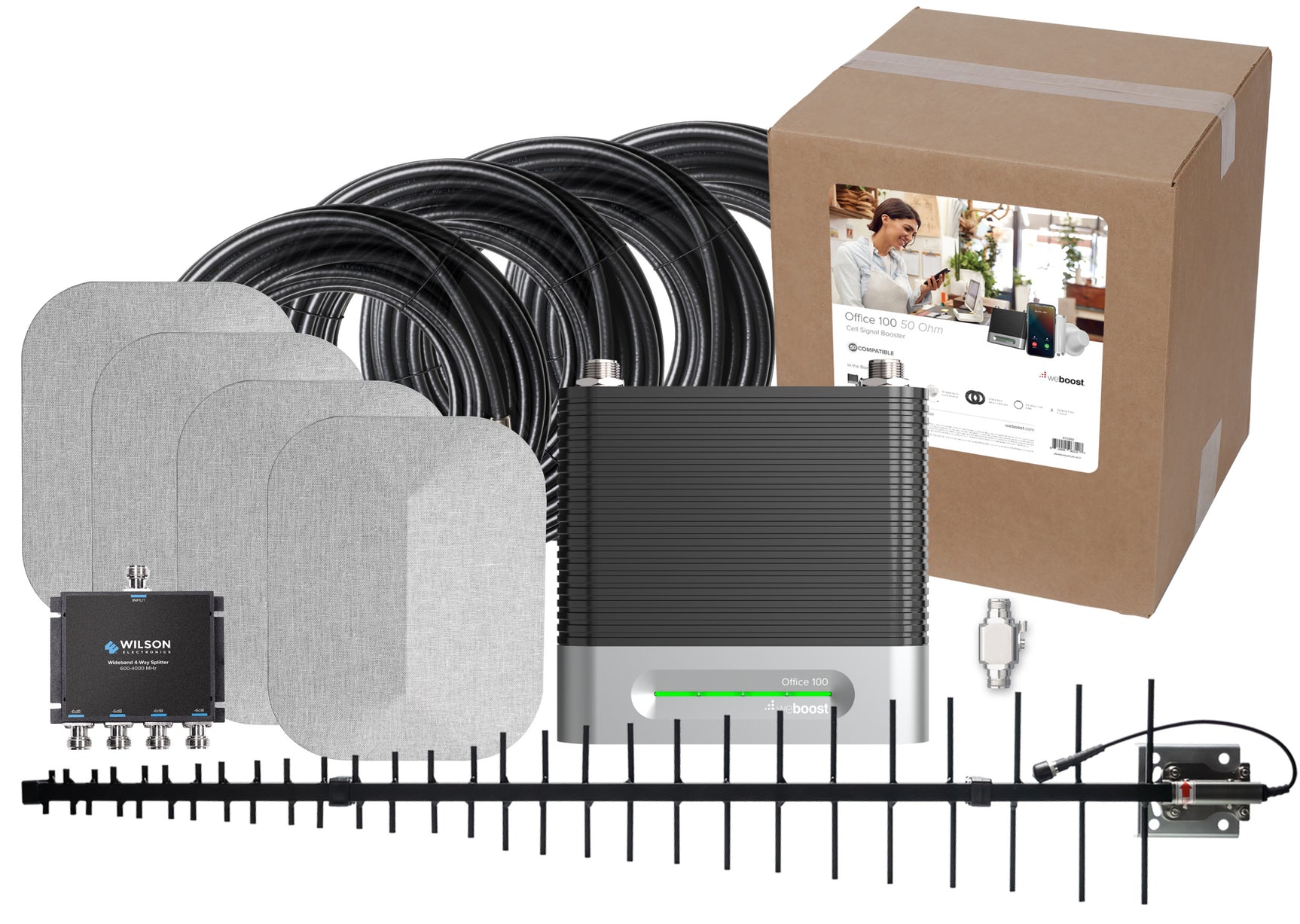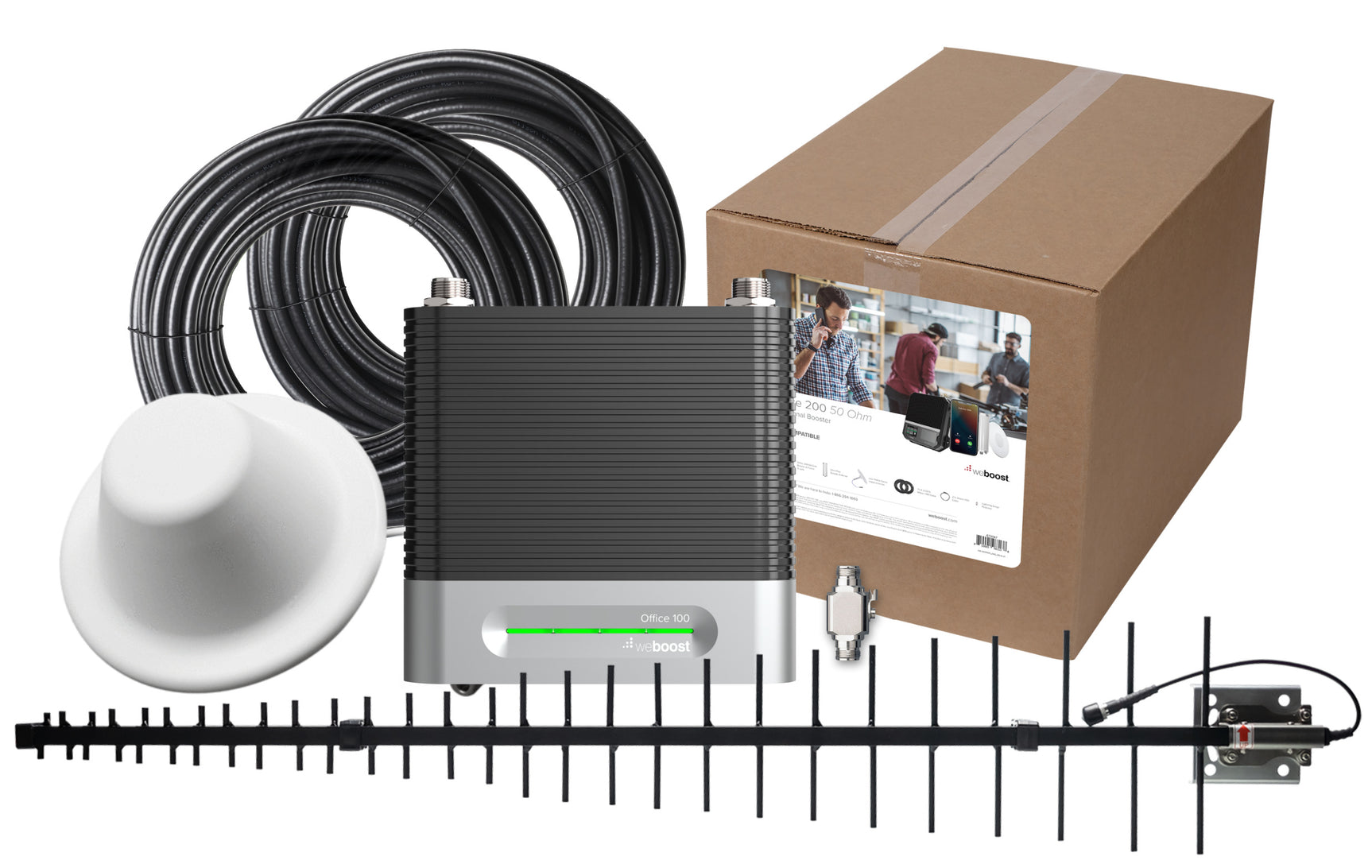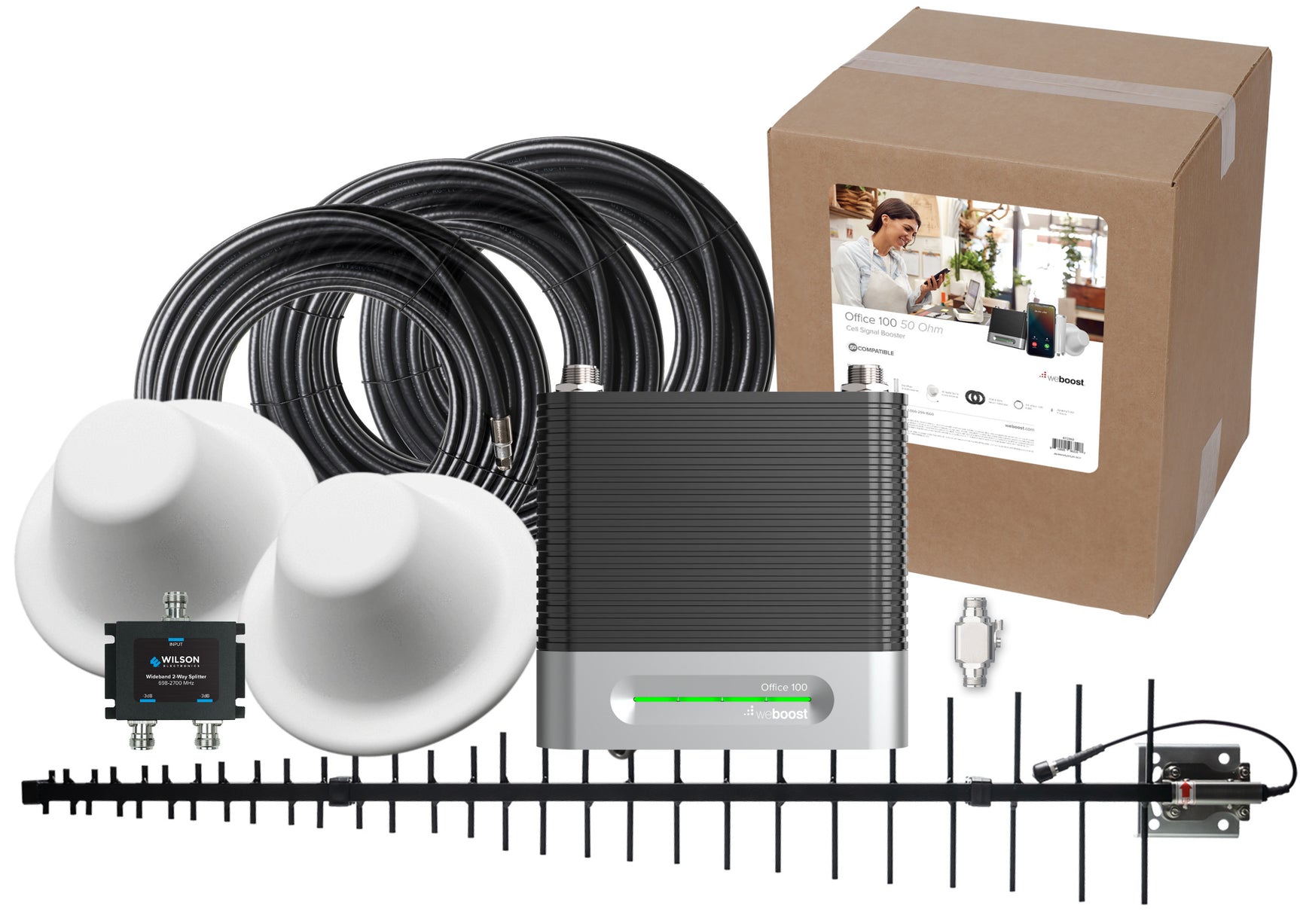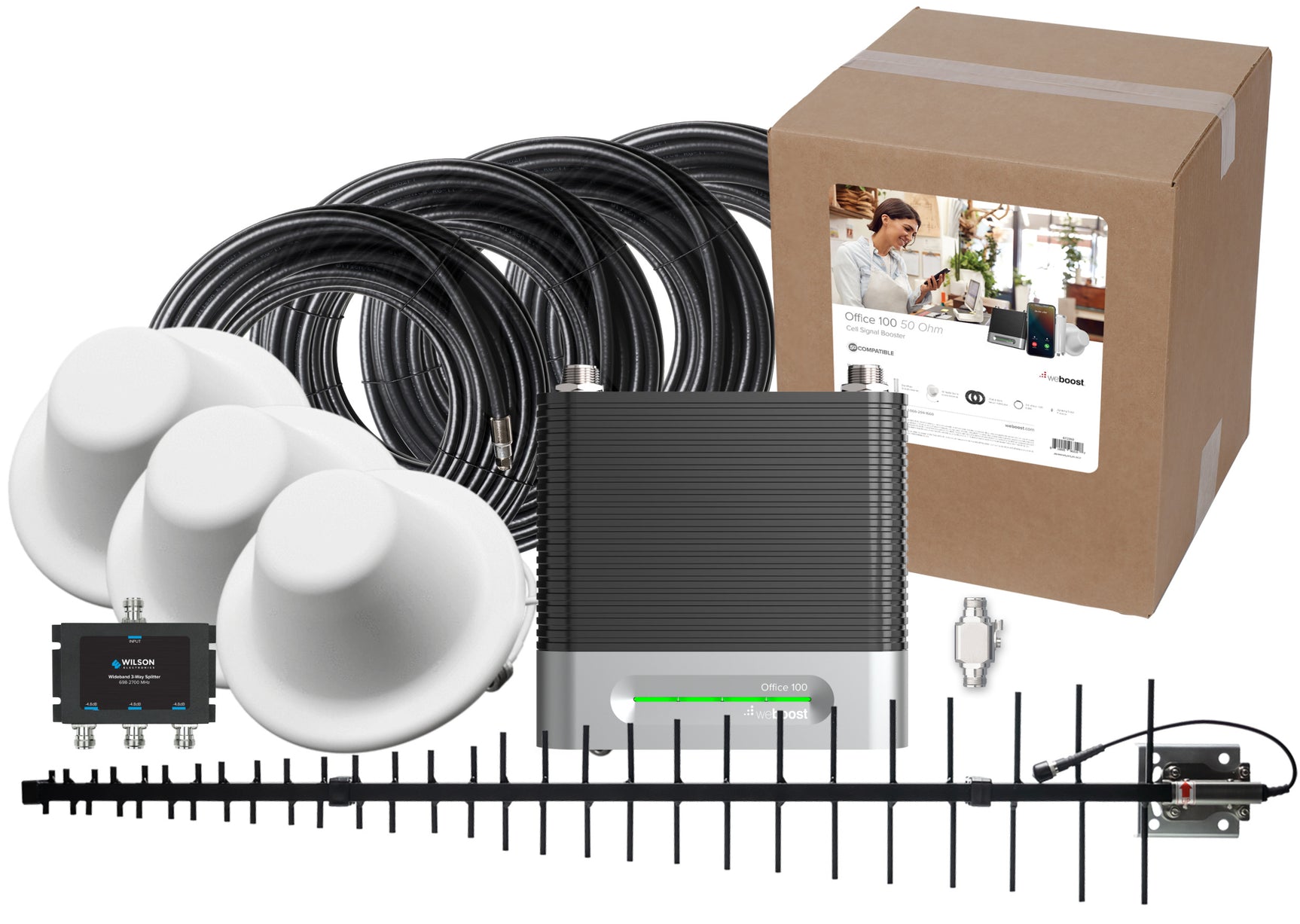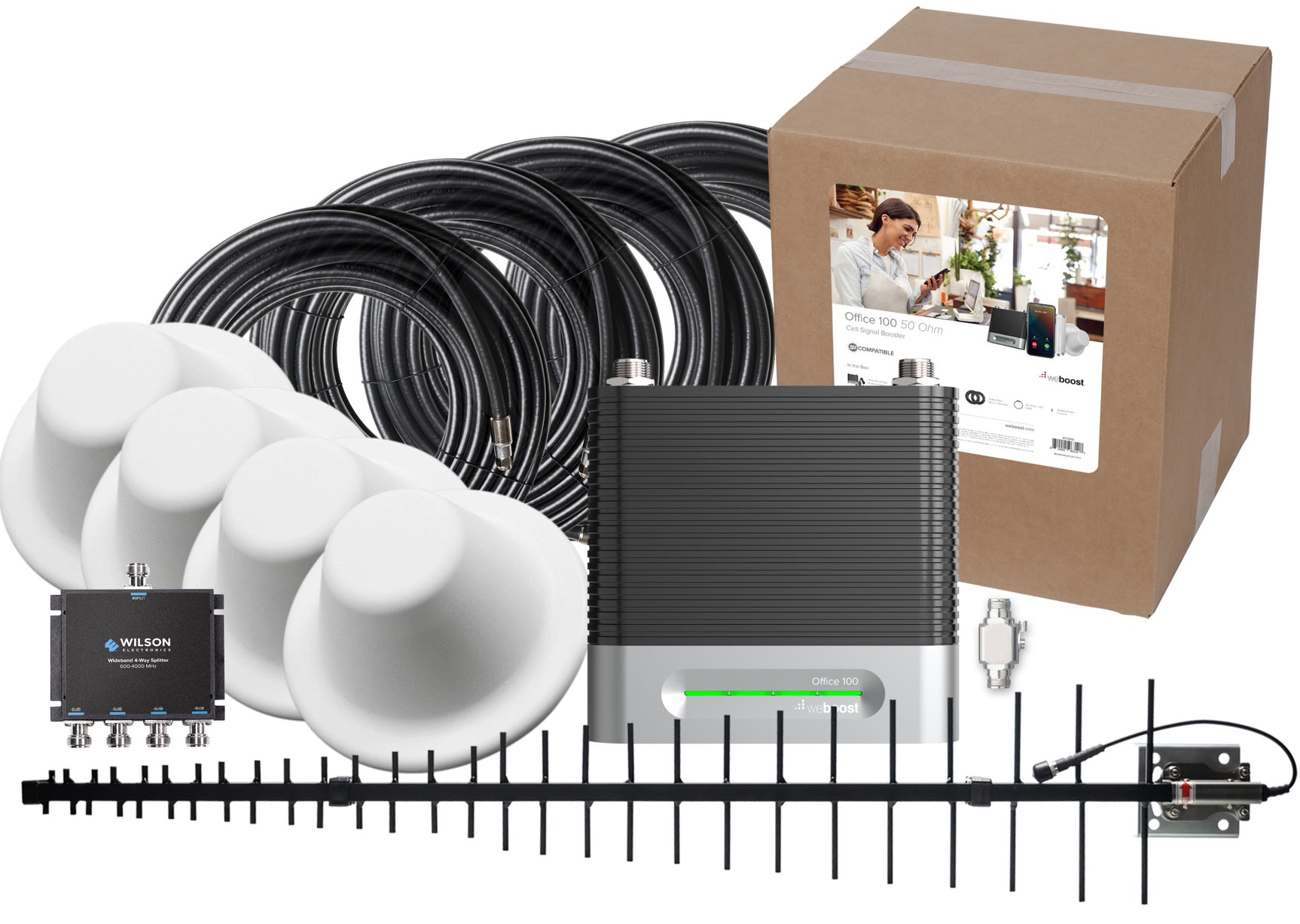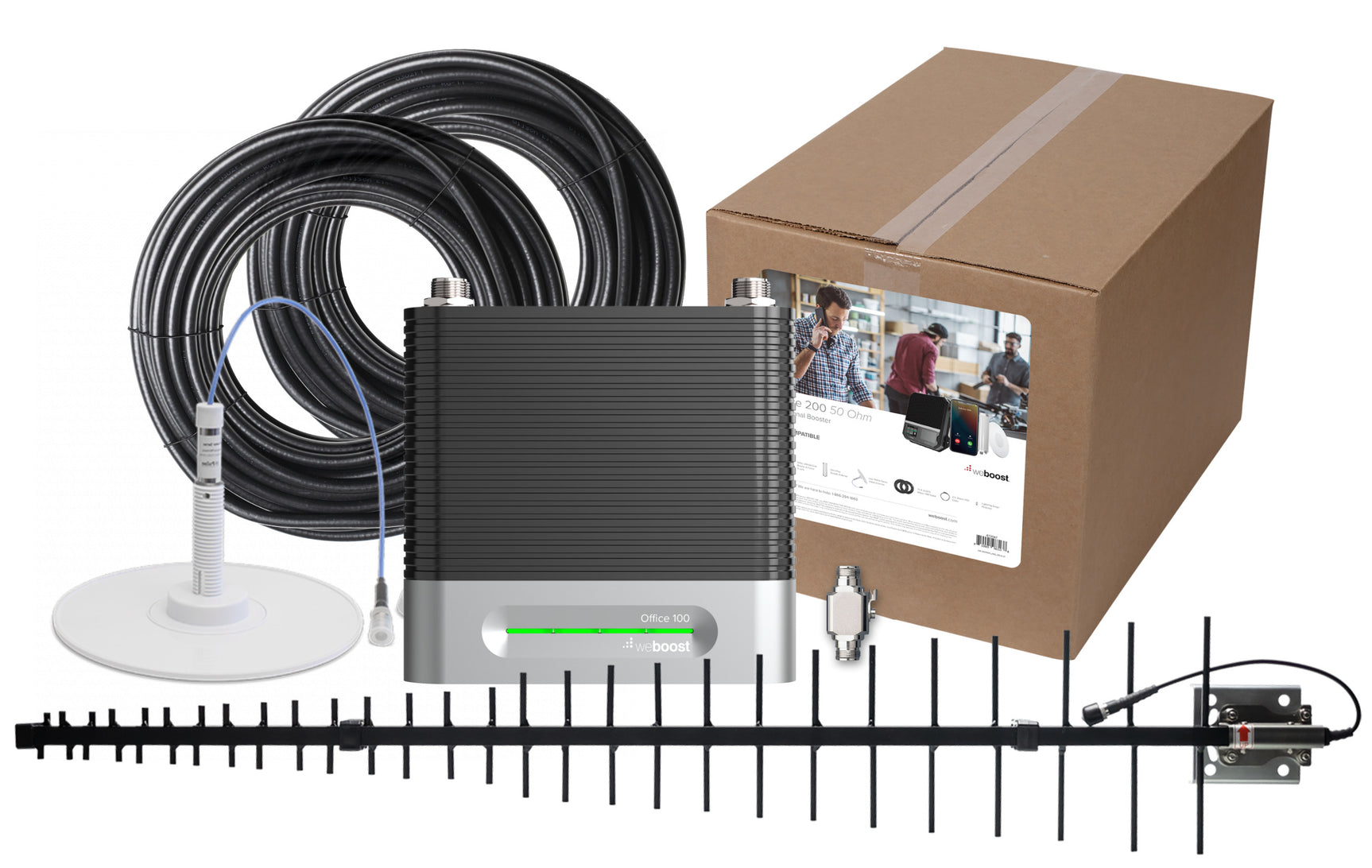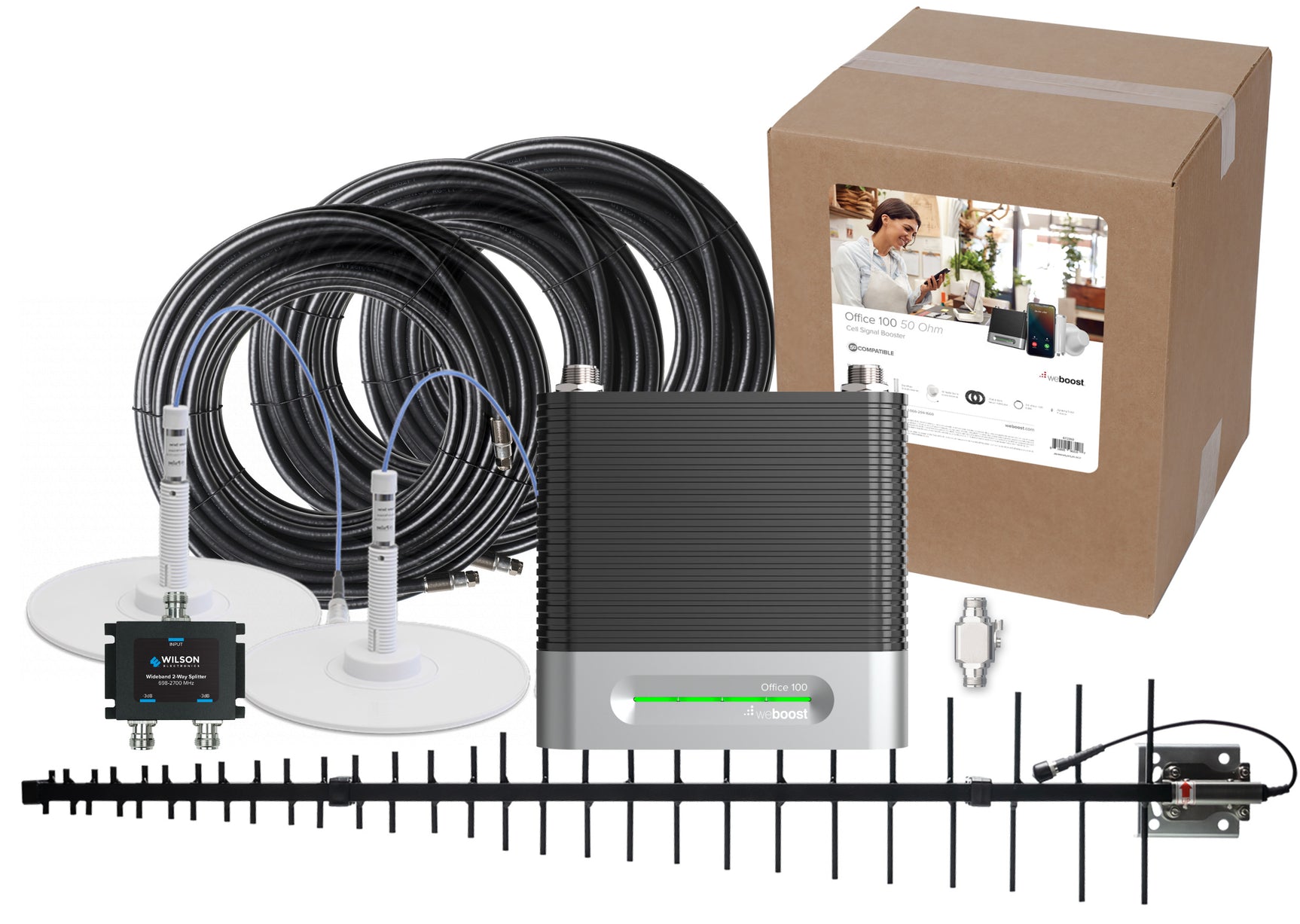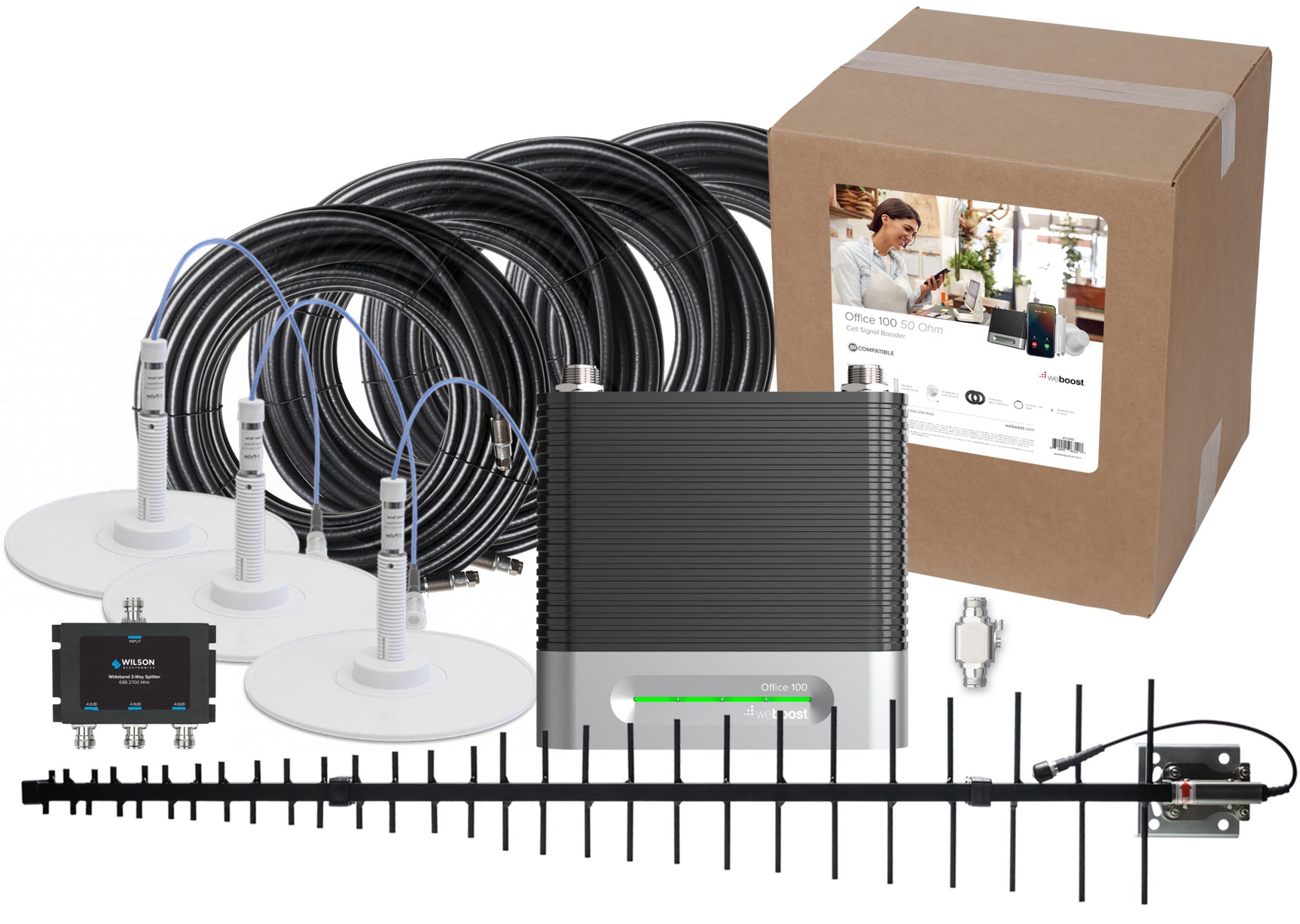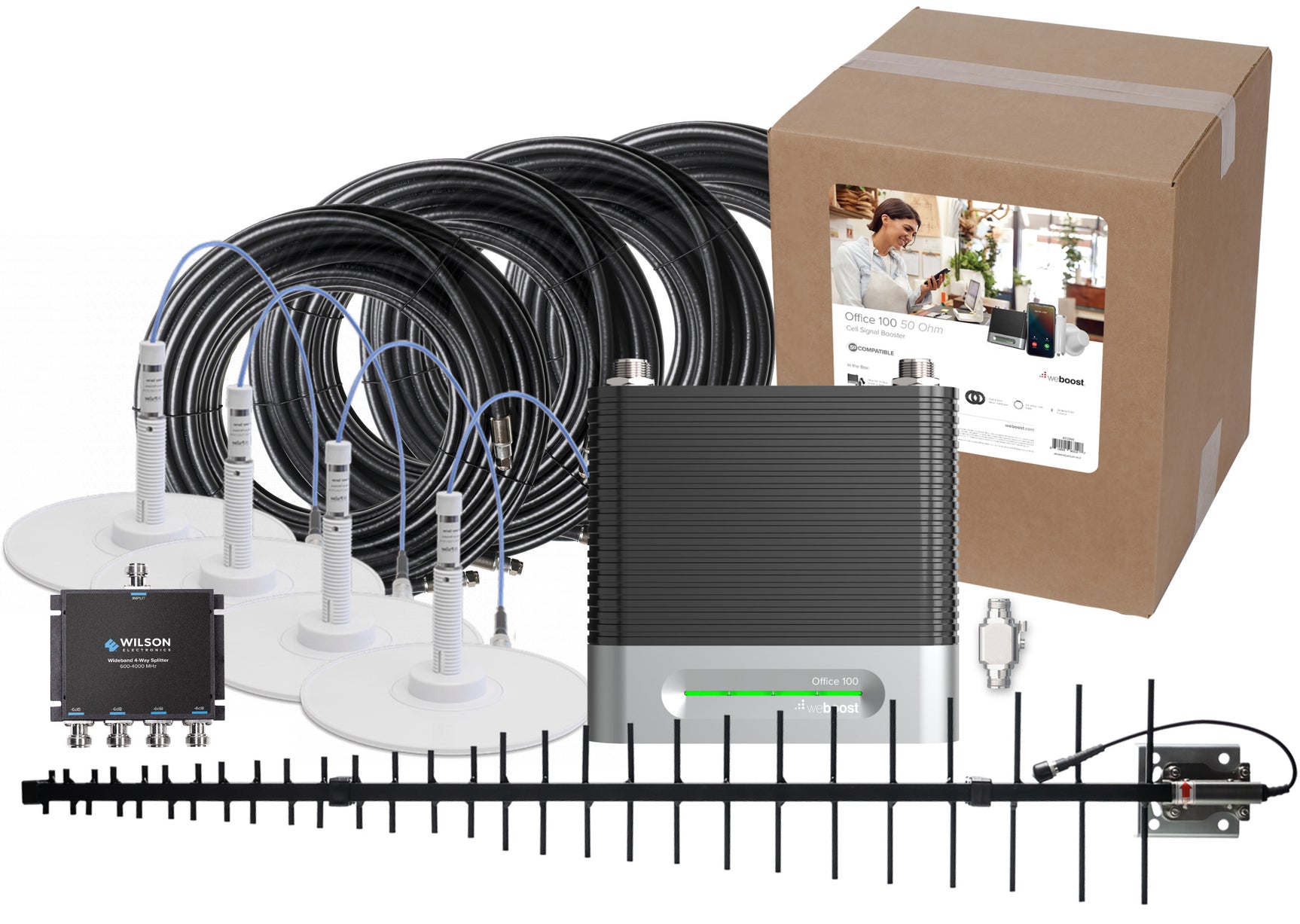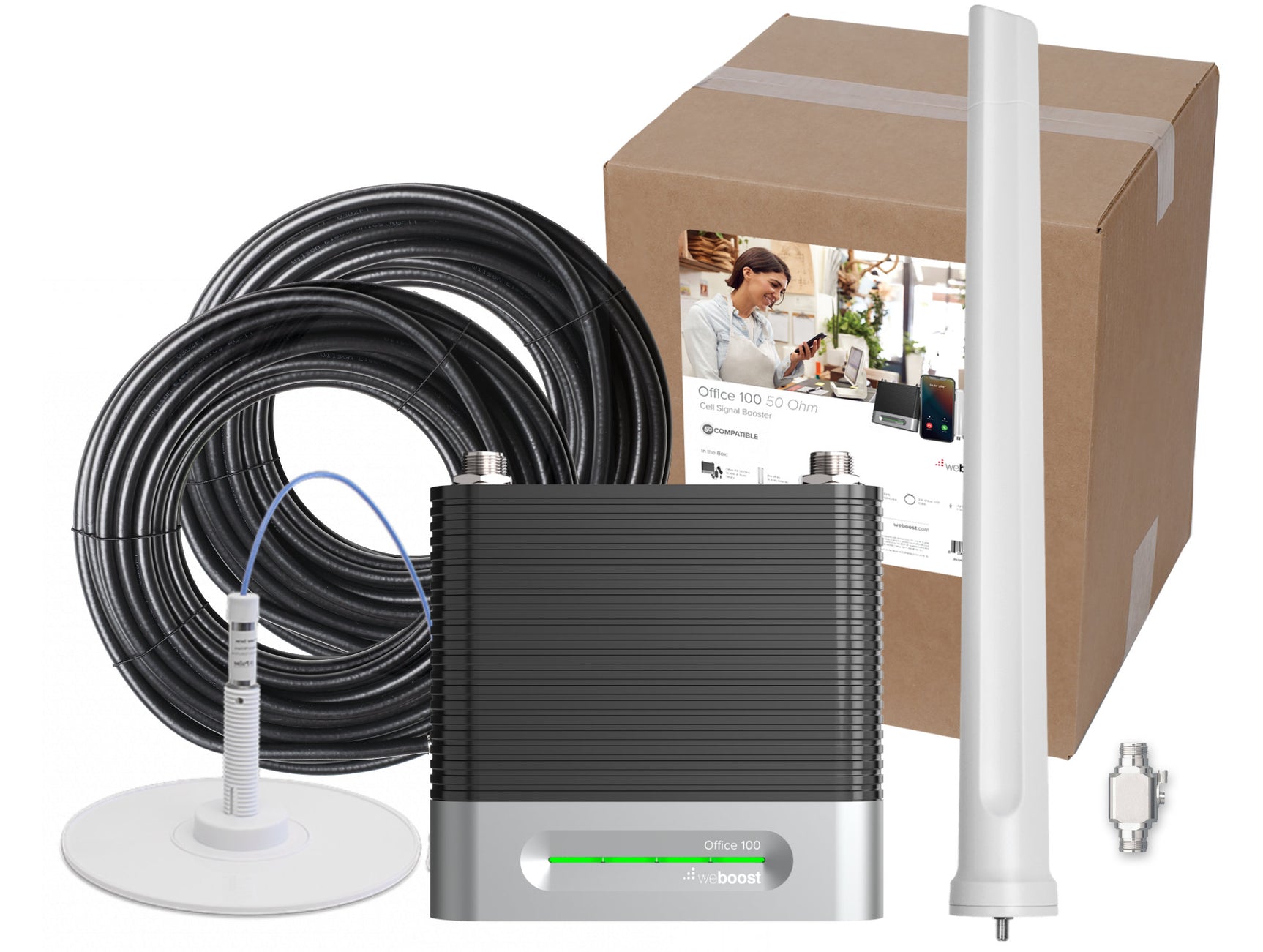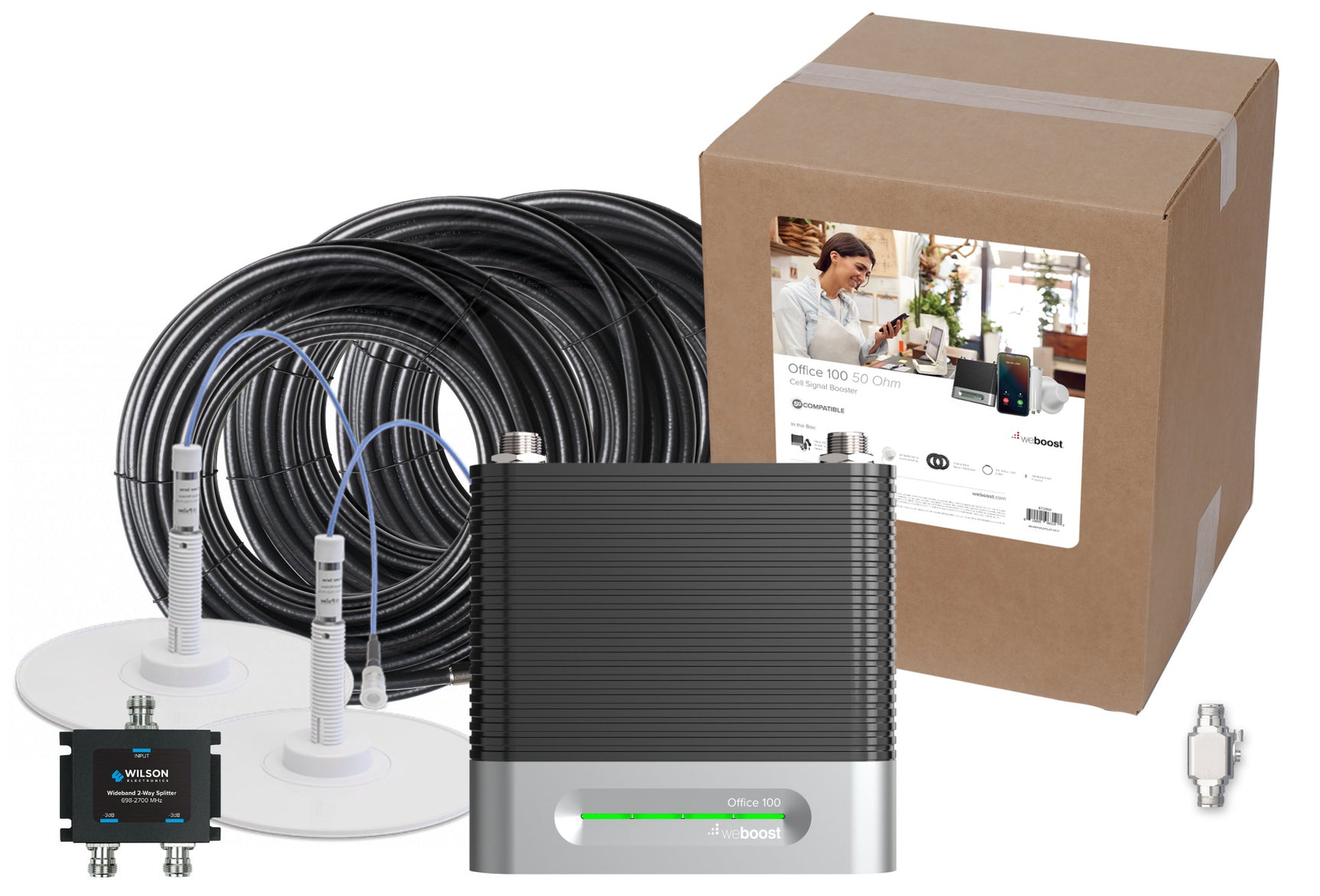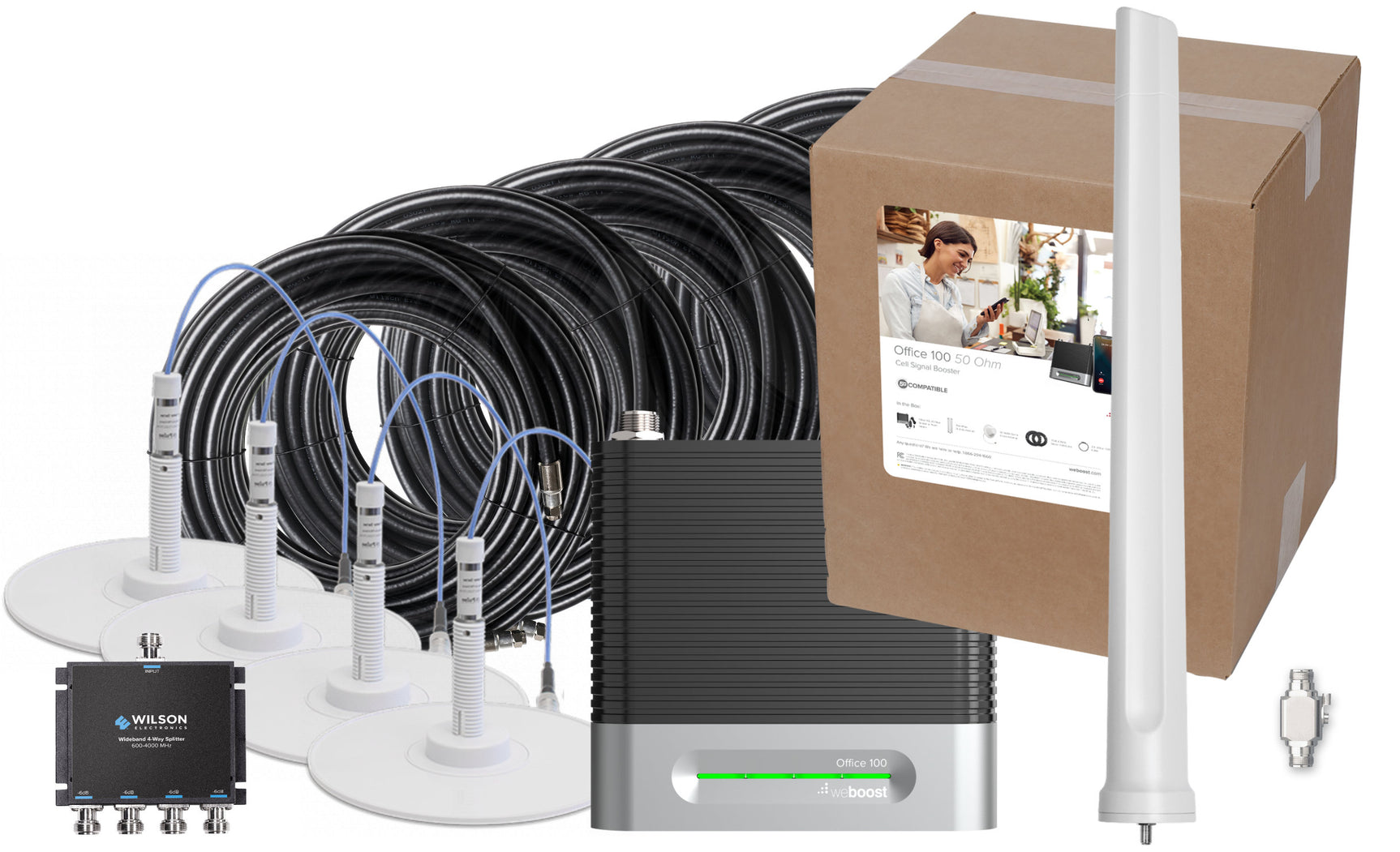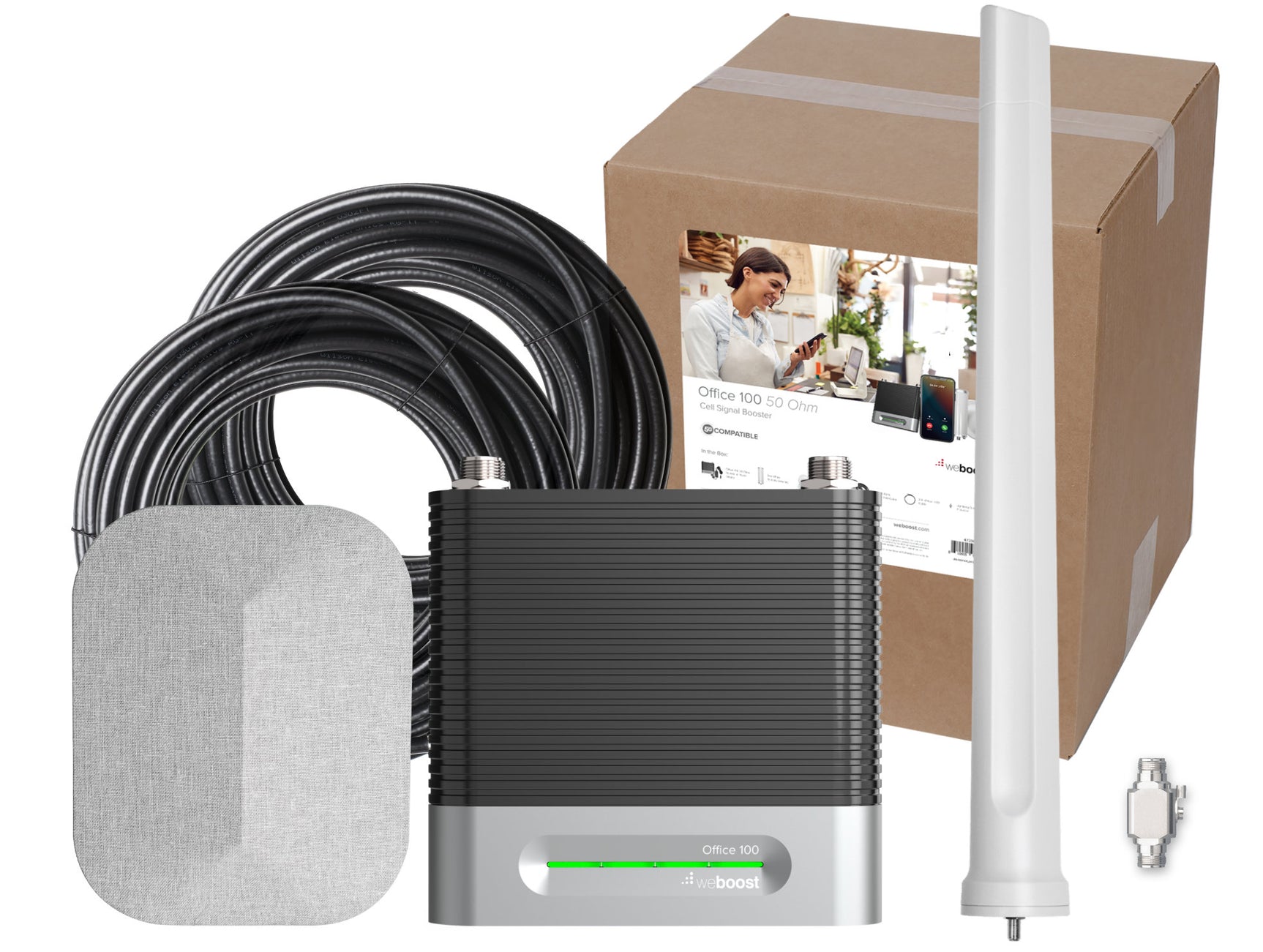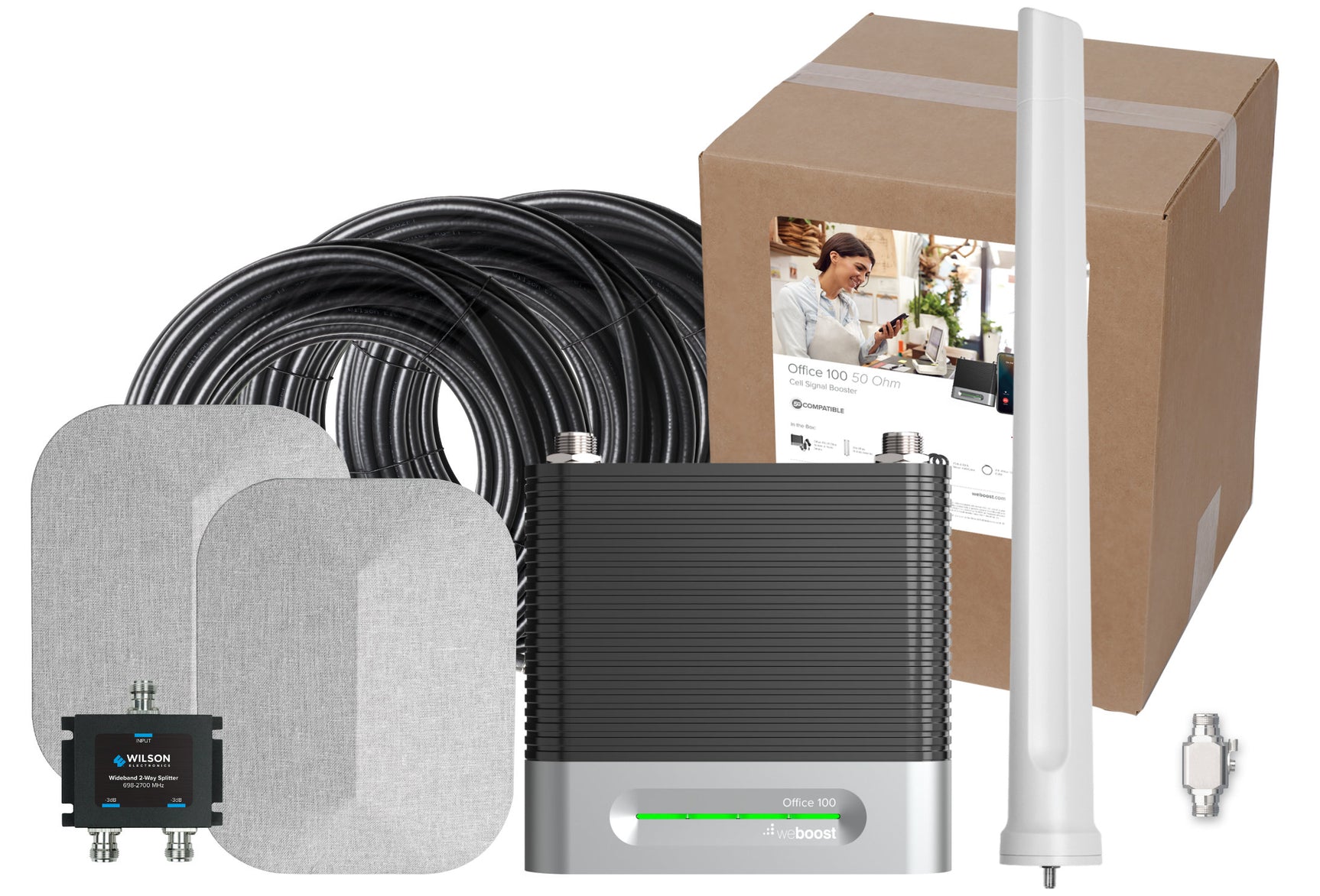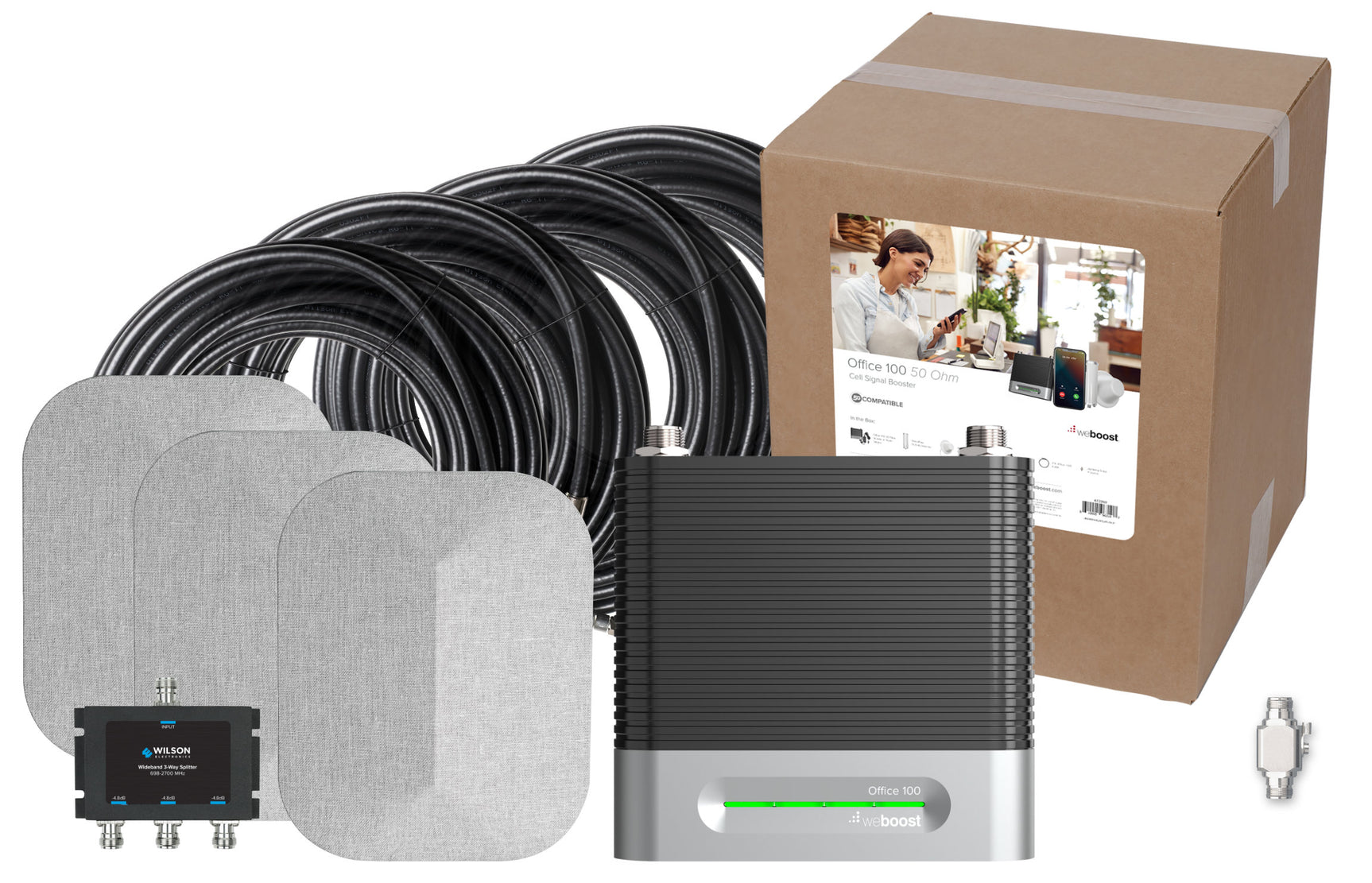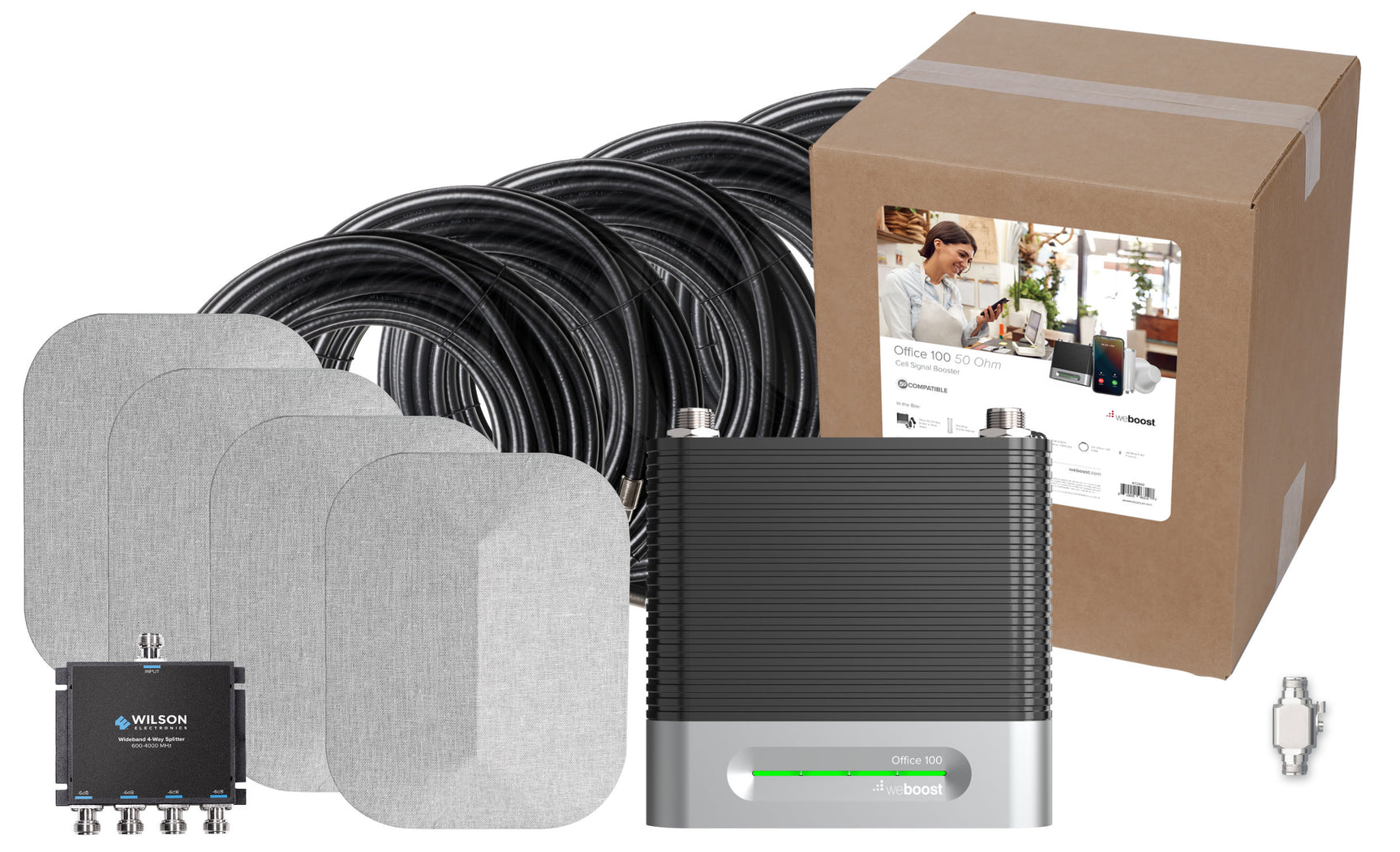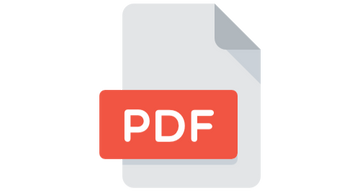weBoost Office 100 Signal Booster (50 Ohm) | 472060
90-Day Returns • Free Shipping $100+ • 3-Year Warranty
How to Choose the Right Antennas for Your Booster
Outside Antennas:
- Yagi Directional Antenna: This antenna is more powerful because it focuses on sending and receiving signals in one direction. It works best when there are no major obstacles blocking its path to the cell tower. It's not ideal for areas with large obstructions like hills or buildings.
- Omni Antenna: This antenna sends and receives in all directions, so it's better for hilly areas or if you need to support multiple carriers with towers in different directions. It doesn’t need to be aimed, but it also isn’t as strong as the Yagi antenna.
- High Gain LPDA Antenna: Perfect for areas with very weak signals, this antenna significantly boosts signal strength. It needs a clear line of sight to the cell tower and requires a sturdy mount because of its size.
- High Gain Omni Antenna: Similar to the standard omni, this antenna receives signal from all directions but delivers significantly higher gain across all supported bands. It’s a much stronger option when you want more inside coverage than a standard omni will provide, especially in areas with weaker outside signal.
Inside Antennas:
- Panel Antenna: Can be placed on walls or ceilings and directs the signal towards a specific area. This antenna is great for homes and tall ceilings in buildings.
- Standard Dome Antenna: Designed to be mounted on the ceiling, this antenna spreads the signal evenly throughout the area. It's best suited for drop ceilings or spaces where cables can be run above the ceiling.
- Ultra-Thin Dome Antenna: This slim antenna also mounts to the ceiling, but is much is less noticeable. It's much stronger than a standard dome antenna, making it a great choice for places where both looks and signal strength are important.
Tips for Choosing:
- Choose Omni Antennas for general coverage with no aiming required.
- Choose Directional Antennas (Yagi or LPDA) when you can point directly at a cell tower and need stronger signal and more inside coverage.
- Interior Size Considerations: One antenna per 750-1,500 sq ft in homes, or 1,500-2,500 sq ft in open spaces like offices and warehouses.
The weBoost 472060 Office 100 is our professional-grade signal booster that delivers reliable cell service in small to medium spaces where connectivity matters most. Tired of dropped calls and sluggish data speeds? This powerful little problem-solver is exactly what you need.
Don't let the "Office" in the name fool you. Plenty of our customers install these in their homes with fantastic results. Whether you're working from your home office, running a small business, or just want better reception throughout your house, the Office 100 has you covered.
In order to give you the best possible solution to improve your cell signal, we've included multiple antenna options for optimal performance with the Office 100 kit. This customizable system allows you to select the perfect combination based on your specific signal situation and space layout. (We'll explain all the antenna options in detail below.)
The Office 100 works with all major US carriers including Verizon, AT&T, T-Mobile, and others, boosting both voice and data signals. Your calls will be crystal clear, your texts will send on the first try, and your data speeds will improve significantly.
The outdoor antennas are designed to withstand harsh weather conditions, and the entire system is backed by a solid 3-year warranty for your peace of mind. Installation requires some basic tools and DIY skills, but the system comes with detailed instructions to help you set everything up properly.
If you need a reliable signal booster for your home, small business, or areas up to 2,000 square feet, the weBoost Office 100 is your answer to poor cell reception.
Please Note: This is a 50 Ohm system with N-connectors. If you need a version with F-connectors, please see the weBoost Office 100 (75 Ohm).
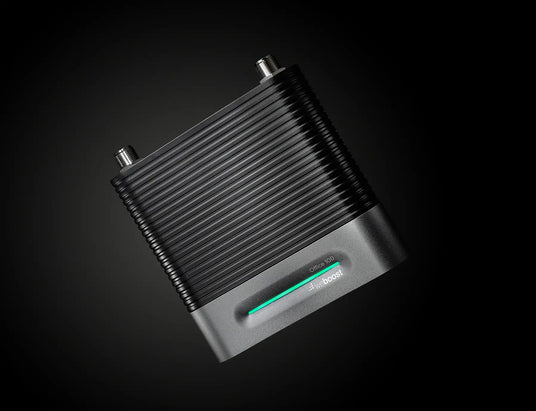
Benefits of the Office 100
- Say Goodbye to "Can You Hear Me Now?" No more phone-against-the-window acrobatics or stepping outside mid-conversation. Enjoy crystal-clear calls and fast data speeds in spaces up to 2,000 square feet.
- Tailor-Made for Your Signal Situation: Whether you're dealing with distant towers or signal-blocking buildings, we've got antenna options to tackle your specific cellular challenges. It's like having a custom suit for your signal needs.
- Plays Nice With Everyone's Phones: No matter which carrier your family or colleagues use, the Office 100 boosts them all simultaneously. Verizon, AT&T, T-Mobile—everyone gets the signal love, no favorites played.
- Turn "Sorry, Bad Connection" Into "Let's Get This Done": Nothing kills productivity like constantly repeating yourself on calls or waiting forever for emails to send. Transform your connectivity from frustrating to fantastic.
- Today's Investment, Tomorrow's Technology: While we can't predict the future, we can prepare for it. The Office 100 supports today's networks and tomorrow's 5G evolution, so your signal solution grows with technology.
- Free Expert Design Help: Not sure which antennas you need? Our signal experts will create a custom plan for your space at no extra cost. It's like having a cellular architect design your solution, minus the fancy fees.
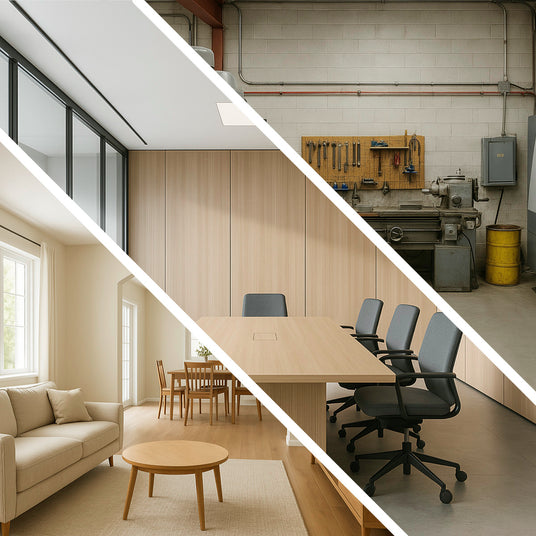
Where the weBoost Office 100 Works Best
- Homes and Residences: Perfect for houses up to 2,000 square feet where signal weakens in certain rooms. Especially effective in buildings with signal-blocking materials like concrete, brick, and energy-efficient windows that prevent cellular signals from penetrating.
- Vacation Properties: Transform your weekend getaway from a digital dead zone to a connected retreat. The Office 100 is ideal for cabins, cottages, and rural properties where distance from cell towers or challenging terrain creates weak or non-existent signal.
- Home-Based Work: Stop apologizing for dropped calls during important meetings. Home offices, remote work setups, and home-based businesses get the reliable connectivity needed for video conferences, client calls, and critical work functions.
- Small Retail and Service Businesses: Keep your point-of-sale systems running smoothly and ensure customers can use their phones in your space. Boutiques, cafes, salons, and small shops benefit from consistent connectivity that supports both business operations and customer satisfaction.
- Professional Offices: Maintain a professional image with clear, reliable communications. Medical practices, law firms, real estate agencies, and other professional offices rely on the Office 100 to ensure client calls connect the first time, every time.
How it Works
The weBoost Office 100 takes weak outdoor signal, amplifies it, and distributes it throughout your space to deliver strong and reliable coverage where you need it most. Here’s how the process works:
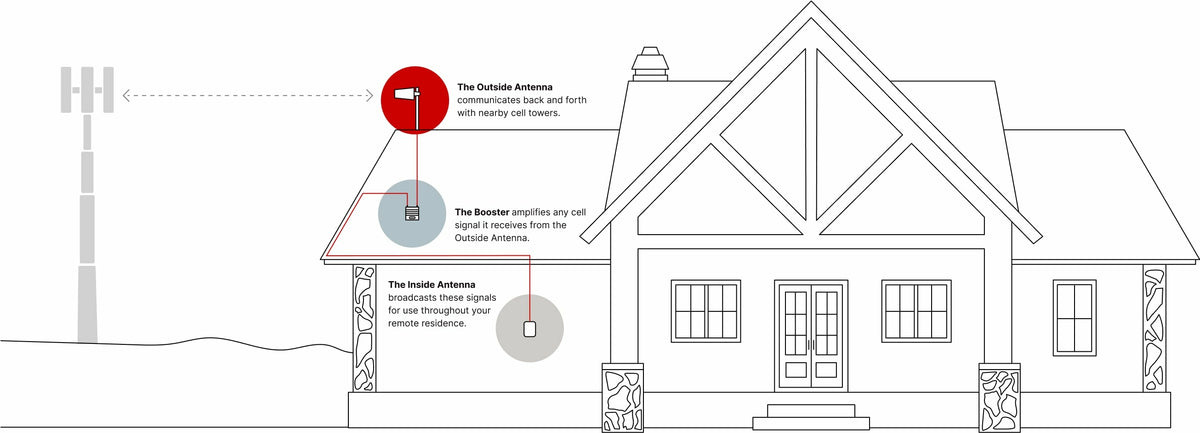
-
![]()
1. Outside Antenna Receives the Signal from the Cell Tower(s)
The outdoor antenna is mounted on your roof and receives the cell signal from the nearby towers. The antenna then passes that signal over a cable to the amplifier.
-
![]()
2. Amplifier Boosts the Weak Signal
The Office 100 amplifier, which is located inside the building, receives the signal and boosts it up to the maximum level allowed by the FCC before passing it on to the network of indoor antennas.
-
![]()
3. Inside Antenna(s) Broadcast the Strong Signal Inside
The inside antenna(s) receive the boosted signal from the amplifier and broadcasts it throughout the space. Multiple inside antennas can be used to provide more inside coverage.
-
![]()
4. Cell Signal is Boosted Back to the Tower
The system also works in reverse. When you make a call or use data, the signal is sent back through the system, gets boosted, and then sent back to the cell tower, ensuring strong signal in both directions.
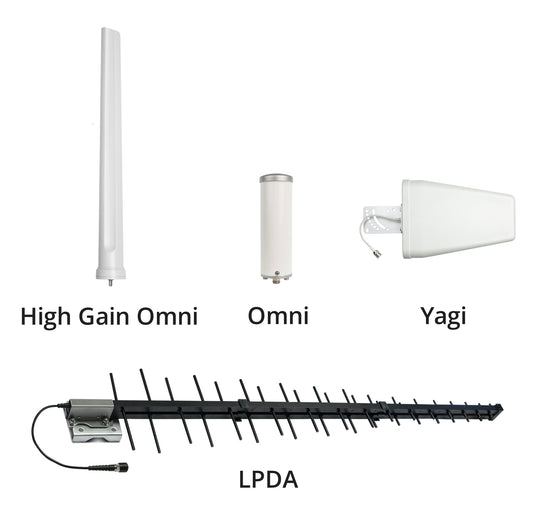
Outside Antenna Options
Choosing the right outdoor antenna makes a big difference in your signal booster's performance. Your location and surroundings will determine which antenna works best for you:
- Yagi Directional Antenna: Great for areas where you have a weak outside signal but can generally tell where the cell tower is. With 10 dB of gain, it gives you solid power and has a 75-degree reception window, so you have some flexibility when aiming it. This makes installation easier than with more precisely targeted antennas.
- Standard Omni Antenna: Works well in hilly or mountainous areas where there's no clear line of sight to a cell tower. It provides 4 dB of gain and receives signal from all directions, so it can capture bouncing or reflected signals. You'll get less indoor coverage compared to directional antennas, but it's really helpful when signals come from multiple directions.
- High-Performance Omni Antenna: For when you want the flexibility of an omni but need more power. This antenna gives you up to 9 dB of gain while still receiving from all directions. It's a good choice when signals come from various towers and the standard omni doesn't quite provide enough indoor coverage.
- LPDA Directional Antenna: Designed for remote locations with very weak signal. With 11-13 dB gain, it's the strongest option available. You'll need direct line of sight to the tower and more precise aiming during installation, but you'll get the most indoor coverage once it's set up correctly. The extra setup effort typically pays off with better performance.
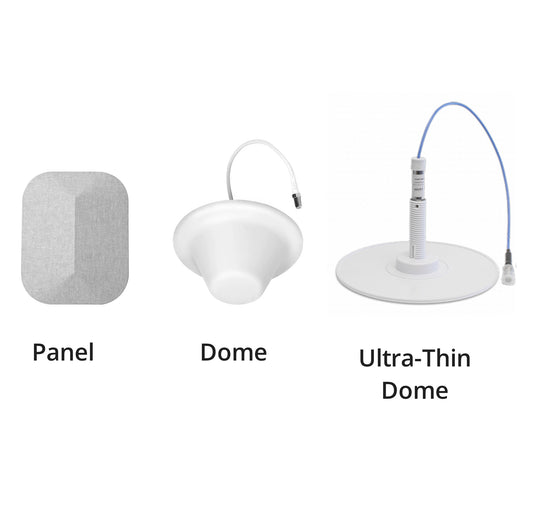
Inside Antenna Options
The type of building you have and how your ceilings are constructed will help determine which inside antennas work best for your space. Here's what you need to know about your options:
- Panel Antenna: This directional antenna mounts on a wall, ceiling, or floor and focuses signal in one direction. It gives you higher power (7-10 dBi) than dome antennas, making it great for targeting specific areas or sending signal between floors. Panel antennas work particularly well in homes with multiple levels, long hallways, or rooms with high ceilings.
- Standard Dome Antenna: This ceiling-mounted antenna broadcasts signal in all directions around it. If you have drop ceilings where you can easily run cables above the tiles, this is often the simplest option. It provides moderate gain (2-5 dBi) and offers good coverage for open office spaces or rooms where you need signal distributed evenly.
- Ultra-Thin Dome Antenna: A more stylish, low-profile version of the standard dome that blends better with your ceiling. If appearance matters in your space, this antenna offers a cleaner look while delivering more power (4-6 dBi) than the standard dome. Like the standard dome, you'll need to run cables above your ceiling for the cleanest installation.
How Many Inside Antennas Do You Need?
For spaces with interior walls, one antenna typically covers about 750 to 1,500 square feet. In more open areas without many dividing walls, a single antenna can cover 1,500 to 2,500 square feet. This can help you estimate how many antennas your space might need for good coverage throughout.
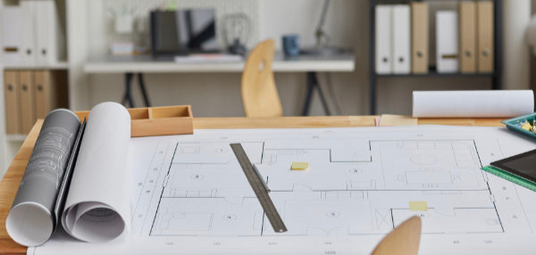
Not only do you get the equipment to start boosting cell signal, but you get an entire time of signal experts at your disposal to make sure that you have everything you need to be successful, including:
- Custom system design and RF modeling. Request that now.
- Priority tech support for optimizing and troubleshooting your new system
- Consultation pre-installation to avoid mistakes
- Access to support materials assembled by our experts on installation pre-planning, troubleshooting, tips and more.
In the Box
-

weBoost 100 Amplifier with Power Supply
-
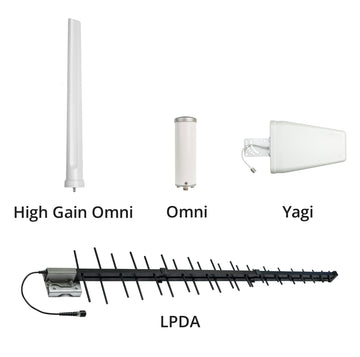
Outside Antenna
(High Gain Omni, Omni, Yagi, LDPA) -

Up to 4 Inside Antennas (Panel, Dome, Ultra-Thin Dome)
-
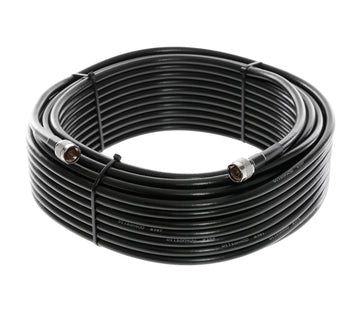
75 ft of 400 Series Cable for Outside Antenna Run
-

60 ft of 400 Series Cable - One for Each Inside Antenna
-
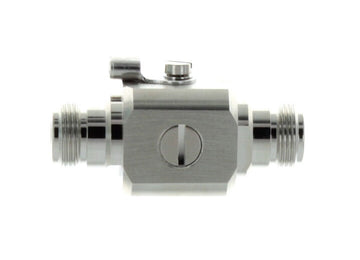
Lightning Protector
-
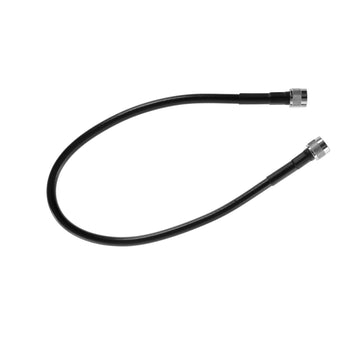
2 ft 400 Series Cable
-
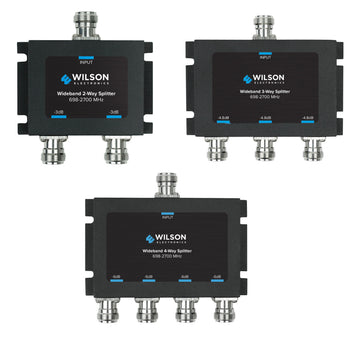
2, 3, or 4-Way Splitter for Multiple Inside Antennas
